Luxe Digital
Conscious, elevated living.
- Men's style
- Women's style
- Stricking superlatives
- Advertising
JOIN OUR COMMUNITY
Receive our finest finds, exclusive deals, and luxury news to stay in the know.
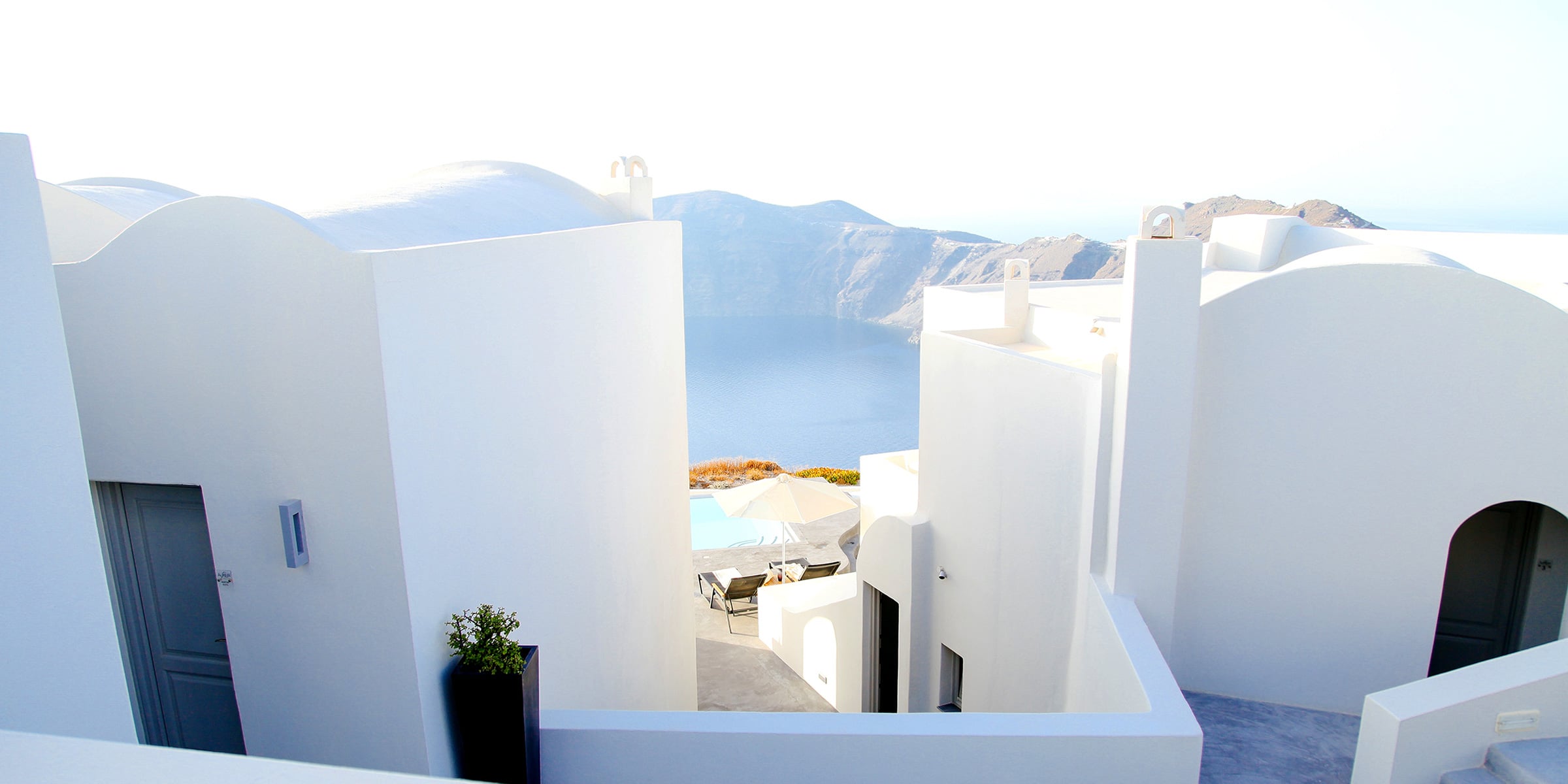

7 Luxury Wellness Travel Trends To Attract The Affluent Travellers
A deck chair by the pool isn’t enough to attract the affluent travellers seeking luxury wellness experiences abroad.
by Editorial Team Updated on November 22, 2022
At Luxe Digital, we independently research, review, and recommend products we love and that we think you will love, too. Learn more about how we curate the best products for you .
This article is part of a series on the future of wellness in luxury .
Discover how rising wellness aspirations are profoundly transforming luxury and redefining affluent consumers’ expectations. See what you should do to connect successfully with your audience.
- Introduction: The Future of Luxury Wellness
Everywhere from dazzling cities to remote exotic destinations, luxury travel is experiencing a healthy boom.
Wellness tourism is now the fastest-growing segment in the travel industry, driven by travelers’ aspirations for a wellness lifestyle. Wellness tourism grew at a healthy rate of 6.5 percent every year since 2015, twice as fast as the tourism industry as a whole (3.2%). [1] In 2017, travelers took 830 million wellness trips – 139 million more than in 2015.
We expect the global wellness tourism sector to be worth $681 billion in 2018. And this is just the start. The Global Wellness Institute (GWI) predicts that the wellness economy will continue to grow over the coming years, reaching $919.4 billion by 2022.
Wellness travel is trending as more affluent consumers incorporate wellness into their lifestyles. From travel and hospitality to fashion , beauty , and fitness , wellness tourism creates opportunities for all businesses to infuse elements of wellness into their offerings to capture travelers’ spending.
Defining wellness tourism: What is wellness travel?
Wellness travel is“ travel that allows the traveler to maintain, enhance or kick-start a healthy lifestyle, and support or increase one’s sense of well-being ”, according to the Wellness Tourism Association.
In other words, wellness travel is about prioritizing one’s physical, mental, and spiritual well-being .
Wellness travel has traditionally been associated with luxury spa holidays. But as self-care has evolved into a daily goal, wellness travel is now taking many different forms and incorporating things like digital detox, healthier food options, fitness concierge, sleep enhancement, and more.
Similarly to the shift that we have observed in luxury retail , experiences are what lure people.
The wellness travel sector is driven by two types of wellness travelers :
- Primary wellness travelers: wellness-minded travelers who are motivated by wellness and whose primary trip purpose is to improve their well-being;
- Secondary wellness travelers: travelers that are seeking to maintain wellness or engage in ad hoc wellness experiences during their regular leisure and business travels but not actively seeking an immersive wellness vacation.

The majority of wellness travels is currently taken by secondary wellness travelers, who account for 89 percent of wellness tourism trips and 86 percent of expenditures in 2017. [1]
The Wellness Premium: Wellness travelers spend on average more than other tourists
Wellness tourism equates to high-yield tourism . Luxury wellness travelers are now willing to pay a premium for healthier hotel stays and wellness products and services while traveling.

Wellness tourism is booming in emerging markets
Asia-Pacific, Latin America, the Middle East, and Africa are emerging as wellness destinations of choice, accounting for 57 percent of the increase in wellness trips since 2015.
Europe and North America currently dominate in terms of the absolute number of wellness trips and expenditures. But Asia is emerging as the growth engine both in terms of wellness trips taken and revenues generated. Wellness trips in Asia grew by 33 percent in the past two years, reaching 258 million trips annually in 2017. China and India are the two fastest-growing wellness tourism markets worldwide, adding over 12 million and 17 million wellness trips , respectively, between 2015 and 2017.
7 wellness trends for luxury hotels
As wellness grows mainstream, luxury travel brands, hotels, in particular, are looking for ways to incorporate wellness into every aspect of the guest experience.

Successful tourism marketing campaigns will tap into these seven critical trends to appeal to wellness-driven customers:
- Transformative wellness travel is the new luxury
- Healthy eating, community wellness, sustainable practices
- Extreme travel experiences for wellness warriors
- Disconnecting with digital detox break
- Female-only wellness travel grows more powerful
- Staying fit on the go
- Architectural design wellness
1. Beyond experiential travel, transformative wellness travel is the new luxury
Luxury travel today has gone deeper than experiential travel. The ultimate luxury now lies in the transformational value of the experience and, ultimately, personal fulfillment.
So-called transformative travel — a travel experience that empowers people to undergo some self-reflection and make meaningful, lasting changes in their lives — has become a prominent demand from today’s high-end travelers. Luxury travelers are demanding transformative experiences that foster emotional, life-changing wellness journeys.
Wellness travellers increasingly demand true brain, body and soul shake-ups – intense personal growth rather than just pampering – and destinations are creatively heeding the call.” Susie Ellis, GWI CEO
In order to appeal to luxury travelers and set themselves apart from the experience-saturated market, brands must clearly portray the transformational, self-actualizing value they can provide or facilitate.

The key pillars of transformational experiences include:
- Shift from ego to self-actualization: Fantasy avatars, theatre, gaming, and role-playing emerge as powerful ways to fire up emotions and ultimately incite a personal transformation.
- Immersive storytelling: Using the power of epic storylines and casting the traveler as the “pilgrim in an immersive story,” brands are leading the traveler in a multi-chapter, story-based wellness journey. [2]
- From passive experience to active journey: Forward-looking travel brands are reimagining the spa experience as an active, nature-roaming journey — mixing up treatments with experiences such as fitness, connection with nature, local and cultural immersion, and healthy food.
Travelers no longer want disconnected programs, classes, treatments, amenities, and itineraries. The new trend is about innovating with true circuits of integrated experiences that lead travelers through “ an emotional, even theatrical, saga of transformation .”
Trend in action: Six Senses Bhutan, multi-property wellness epic circuit
Six Senses Bhutan immerses travellers in a narrative-based wellness pilgrimage in Bhutanese values and culture. Guests journey across five intimate lodges (from Paro to Thimphu to Punakha to Gangtey to Bumthang) in diverse topographies, climate zones and cultural areas, where they discover – chapter by chapter – programming based on the five pillars of Bhutan’s unique Gross National Happiness Index.
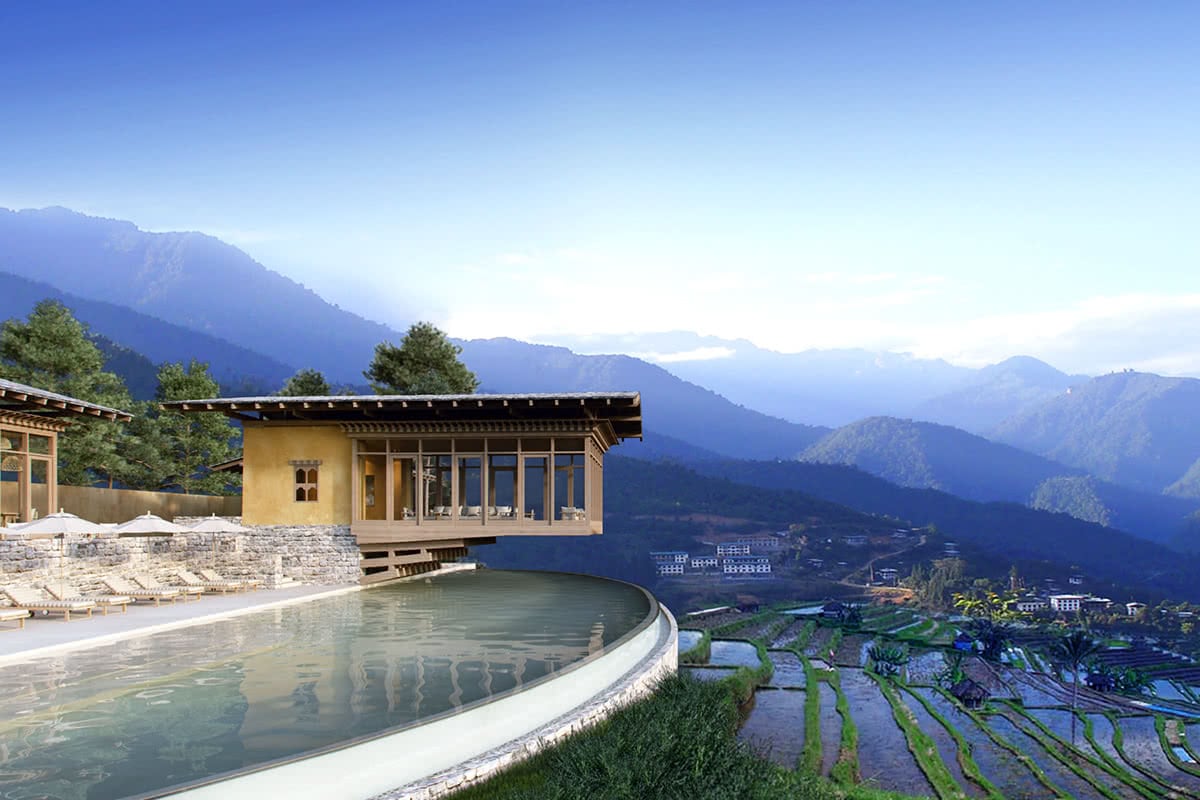
2. Healthy eating, community wellness, sustainable practices
Sustainability and social responsibility are key to the wellness tourism industry. Luxury wellness travelers are interested in both their own well-being but also their impact on the overall well-being of communities around them.

An increasing number of individuals now want healthy, organic, local food and choose to be vegan or vegetarian. The popularity of the “farm-to-table” concept has exploded in recent years. What was once seen as the province of hippies is now in demand and more mainstream. And consumers don’t mind paying a premium to meet these values.
What does it mean for luxury hotels :
Luxury hotels and resorts should look at sourcing local produce, supporting local farmers, and implementing sustainable practices. Luxury hotels can also consider adding a selected number of healthy options to their minibars and on their menus (such as raw, vegan, gluten-free, or simply low-calorie).
3. Extreme travel experiences for wellness warriors
Taking extreme challenges, treatments, and experiences to produce wellness benefits is gaining popularity. A prime example is UK luxury travel company Black Tomato, which takes affluent travelers out of their comfort zones on tailor-made trips (in a selected terrain, whether polar, jungle, desert, mountain, or coastal) that take months to prepare for the mental and physical challenges and cost upwards of $30,000.
4. Disconnecting with digital detox break
More travel offerings will explicitly be about cutting digital connections and logging off from the world.
Mandarin Oriental spas, for example, offer a Digital Wellness experience where no electronic interruptions are allowed, including during the check-in silence ceremony.
5. Female-only wellness travel grows more powerful
More wellness travel will be aimed at women’s physical, mental and spiritual empowerment.
From challenging adventure travel for the solo woman to female-only transformative retreats to heal emotionally post-grief or trauma (like post-divorce/break-up retreats).

6. Staying fit on the go
Many wellness travelers wish to stay fit while traveling. In light of the recent demand for increased wellness options while on the road, hotels are investing in new fitness equipment and technologies.
Fitness retreats—luxury vacations set around an itinerary full of workouts, wellness experiences, and feel-good foods—are also expanding. From ClassPass to W Hotels to Equinox, big lifestyle brands are entering this fitness tourism sphere.
7. Architectural design wellness
Another growing trend in the luxury wellness travel industry is wellness architecture. The idea is to design beautiful but also comfortable, functional and sustainable spaces with materials addressing both physical and mental wellness.
How luxury hotels are investing in wellness
As affluent travelers take wellness seriously, luxury hotels follow suit. The concept of wellness is taking center stage at some of the world’s most exclusive hotels.

Focused on various wellness pillars, including nutrition, sleep health, movement, holistic treatments, meditation, and mindfulness, Six Senses Integrated Wellness is a great example of how luxury hotels can infuse wellness in the guest experience.
Sleep With Six Senses initiative is about providing guests with natural, hand-made mattresses and cotton bedding with built-in motion detectors to track how guests sleep, allowing hotel staff to then develop customized therapies based on the individual sleep data. See our round-up of the best luxury mattresses to get an idea of the brands they’re working with.
A bespoke wellness screening using smart technology also enables Six Senses’ in-house wellness experts to personalize one’s wellness program – such as spa treatments, nutritional advice, and fitness and wellness activities the guest should do at the property.
Six Senses also offers low-sugar, low-gluten, low-soy, and low-lactose meal options, which are as clean, sustainable, and locally sourced as possible.
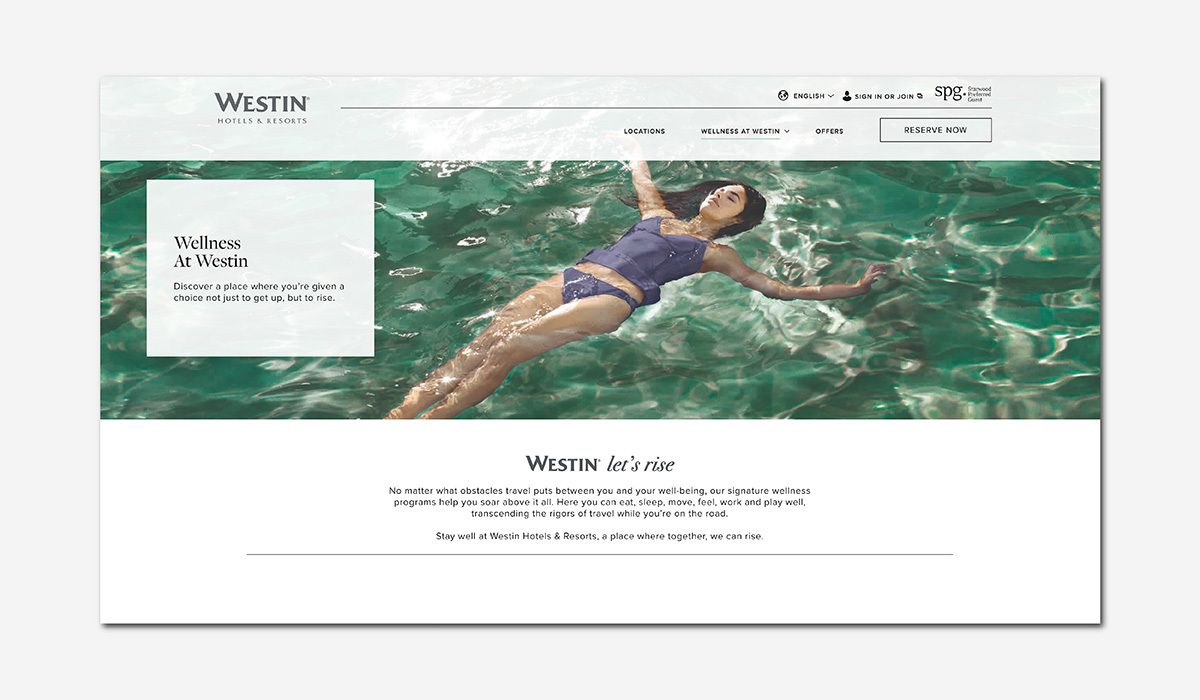
Westin’s Six Pillars of Well-being (Sleep Well, Eat Well, Move Well, Feel Well, Work Well, and Play Well) is a great example of how wellness is increasingly being integrated into every aspect of the hotel experience.

Marriott also offers affluent travelers the opportunity to sleep in a “ Stay Well ” hotel room, featuring air purifiers, a dawn simulator to minimize jet lag and sleep disruption, as well as personalized circadian mood lighting, aromatherapy, and Stay Well Shower Infuser that reduces chlorine to keep hair and skin soft and smooth, and more. Guests can also download a Stay Well Mobile App offering a guided meditation podcast, a Jet Lag tool, and sleep, nutrition, and stress-management programs.
Final thoughts
Affluent travelers are increasingly looking at hotels and luxury travel brands that infuse well-being into the very essence of their experiences and elevate them to be at their personal best.
Keeping a high-touch, personal approach while adapting to the increasing wellness expectations of today’s affluent travelers will be key to survival for luxury travel brands.
As wellness-minded travelers become more sophisticated, they are demanding a more integrated, multidimensional approach to wellness – from food to mood, sleep to movement – at properties and destinations.
Luxury hotels will need to consider everything from refinements of their amenities to clean restaurant menu options, wellness concierges, in-room entertainment content, natural toiletries, affiliations with other health businesses, and more.
- Wellness Economy Monitor , by the Global Wellness Institute, October 2018.
- Wellness Activities Will Have Strong Ties With Luxury Travel in 2018 , Laura Powell, Skift, January 30, 2018.
About the author

Editorial Team
Luxe Digital is an independent media brand, and premier online destination inspiring millions of people like you to live their richest lives—beyond bling. Our award-winning editorial team is a global team of content creators and editors. We are journalists, strategists, analysts, creatives, travelers, and luxury insiders—all with high standards and even higher values.
Learn more about Editorial Team

Cuyana Easy Tote Review: Going Places Has Never Been Easier
A life in motion made effortless.

Standing Tall: Oakywood Adjustable Desk Doesn’t Sit Still

Beyond Playthings: The Most Expensive 1000% Bearbricks Ever Sold

Eberjey Gisele Pajamas Review: Classic Cocoons Of Comfort

The Most Expensive Basquiat Paintings Are Message-Infused Masterpieces

15 Rarest Cars in The World – From Alfa To Zagato

Beyond The Velvet Ropes: London’s Most Exclusive Private Members’ Clubs

Luxury Lumber: The Most Expensive Wood In The World

Decadent & Diplomatic: The Most Exclusive Private Members’ Clubs In Brussels

Amberjack Boots Review: Part Boot, Part Sneaker, All Comfort
Proudly inspiring millions of readers like you .
Your Conscious,
Elevated Life
Starts Here.
- Striking superlatives
Thoughts on the high yield tourist
- Published: Saturday, May 4th 2013
- by Spafinder
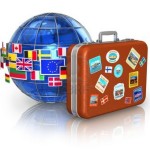
It was the first time I heard the term “high yield tourist” however I immediately recognized its huge importance to wellness tourism and spa tourism worldwide. The “high yield tourist” is something governments and private business know is very important – it brings in travelers who spend more money than other tourists often do. Also wellness tourists often don’t do as much damage to a country’s environment and thus are attractive from that point of view also.
The concept reminds me of the findings from many hotel groups that have evaluated the spending patterns of their guests. They have found that those guests who use the spa spend a lot more money in general than those who don’t use the spa. (Sometimes even twice as much on average!)
It was last week in New Delhi – we were sitting in the office of the man who is credited with spearheading the wildly successful “Incredible India” campaign – Amitabh Kant. In fact he had just handed us the book he wrote about that topic called “ Branding India: An Incredible Story .” I was in India with Andrew Gibson (Mandarin Oriental, Hong Kong) and Professor Marc Cohen (RMIT, Australia) where we were making further preparations for the 2013 Global Spa and Wellness Summit that will take place October 5-7.
We were aware that Amitabh Kant was one of the key visionaries who put wellness tourism on the map – not only for India but for the world. In 2000 he was minister of tourism for Kerala and launched the “God’s Own Country Campaign” that introduced this beautiful region to the world and branded it as the cradle of Ayurveda. He later went on to work with India’s national government and developed the Incredible India campaign that resulted in showcasing the color and diversity of India – all under one banner. He explained that the foundation of the campaign was actually the wellness aspect of India…featuring yoga, meditation and Ayurveda.
He explained that his goal was to target the “high yield tourist,” knowing that if he could do that, others would follow. And that is exactly what happened.
There isn’t a great deal written yet about this “high yield tourist” – however it is a concept that will likely be discussed more often in the future. Check out this study from Australia: Concepts of Tourism Yield and Their Measurement .
Note their observation :
“G enerally it is not the number of visitors per se that is the goal of tourism marketing but the expenditure associated with those visitors. Moreover, it is well recognized that greater numbers also generally imply greater social and environmental impacts. In this report we develop yield measures based on the financial and economic effects of visitor expenditure rather than visitor numbers.”

About the author : Spafinder
At Spafinder, we want you to explore spa in every way. From experiential videos to special offers and beautiful photography so you can take a sneak peek before your visit. Enjoy wellness inspiration and spa insights that make keeping well easier, each and every day.
Most recent from Spa


- Service Providers + Destinations
- Content Creators
- Collaborations + Partnerships
- What is Rooted?
- Rooted’s Founder
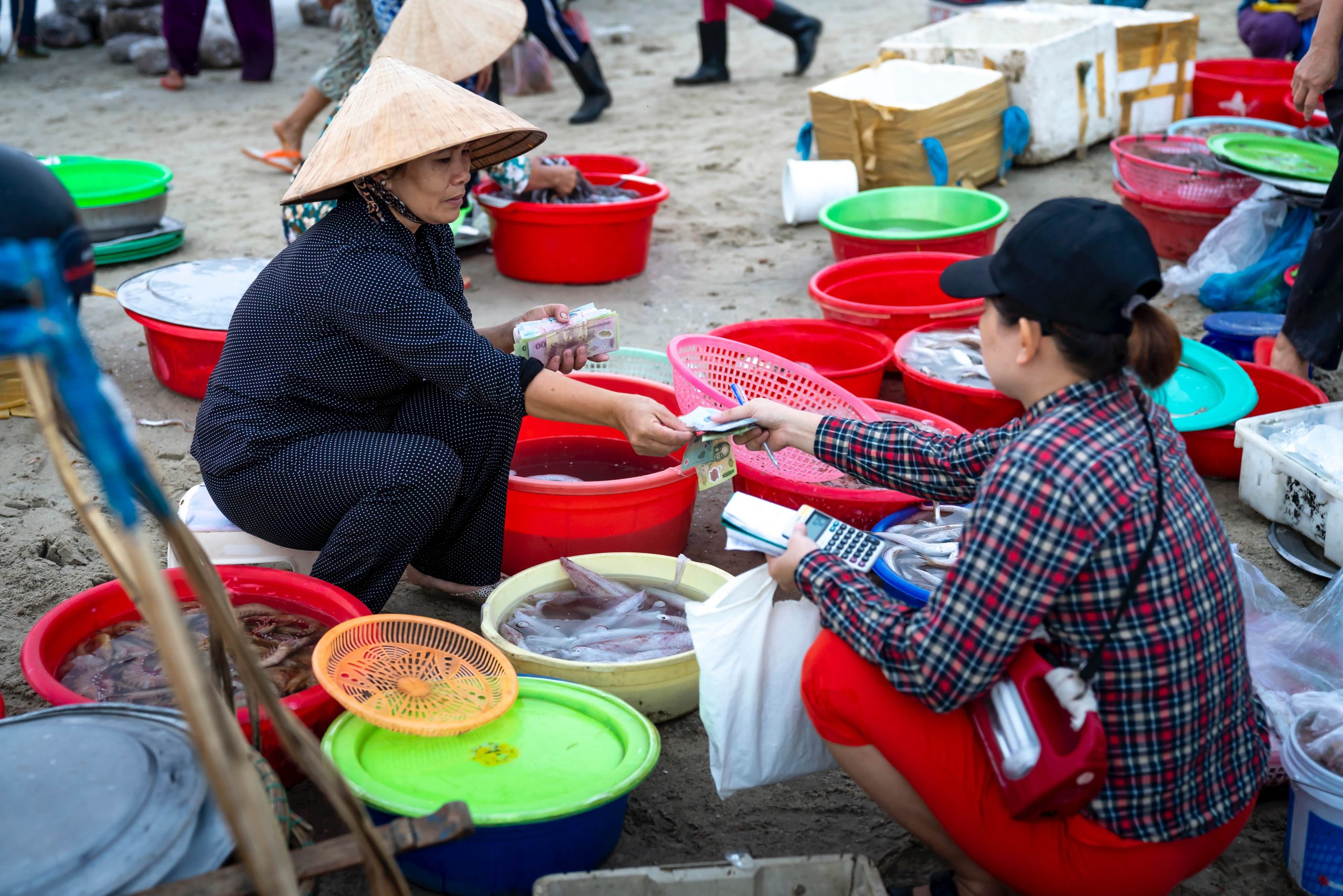
Focusing on high financial value still keeps the tourism industry's focus on a quantitative metric. | Photo by Quang Nguyen Vinh
Rethinking Tourism
March 27, 2023
What Defines a “High-Value” Traveler — and Would a Shift in Perspective Make a Difference?
Preparing for a recent speaking engagement, I browsed the notes put together by a panel moderator. It’s common to receive a tentative outline and relevant questions to help guide the conversations, even if they end up being fairly organic in the moment.
Yet, reading over these notes, one of the questions posed by the moderator stood out to me: What can we do better to attract the “high values” traveler committed to sustainable tourism and respecting local communities and cultures?
I mulled over the question.
We talk a lot about the high-value traveler — the person who, presumably, has the potential to spend a lot of money while visiting a destination. A search on the term “high-value travelers” notes they are likely to spend more, stay longer, and disperse beyond hotspots. Additionally, they’re motivated by nature, wildlife, aquatic, food, and hands-on experiences.
So, there you go: The high-value traveler as defined by the tourism industry.
Yet, these definitions still tend to feel a bit boxed in to me. “Value” isn’t restricted to finances, so perhaps a high-value traveler could offer a social, cultural, or educational benefit to a community as well.
This leads me back to the question I found tucked between one on greenwashed narratives and another on strategies for approaching complex sustainability issues.
Was the addition of the “s” on the word “value” a slip of the finger on the keyboard, or was it intentional? Because, if it was intentional, this brings up a point we’ve not examined in tourism. And that point is: Are we still attracting the wrong travelers for the wrong reasons?
Certainly, the financial benefits of tourism cannot be understated. According to the World Travel & Tourism Council , tourism was expected to contribute US$8.6 trillion to the global economy in 2022. That’s only 6.4% less than pre-pandemic levels. And, given the explosion of travel in just the first quarter of 2023 (despite global challenges like the climate crisis and increased costs of living), this number seems likely to blow any 2019 figures out of the water.
So, yes, the financial benefits of tourism matter. A lot.
It is, in fact, one of the tools gatekeepers are using to keep these massive traveler numbers in check. With more destinations implementing or increasing visitation fees, and price increases on everything from airline tickets to restaurant meals, one could argue that leisure travel is becoming more elitist by the day .
In other words, the tourism industry is taking action so that only “high-value” (i.e. financially flush) travelers have the means to go on holiday. More money, fewer people. The scales are tipping in the right direction, yes?
I’m not so sure. Even if the high-value traveler stays longer and spends more, isn’t that moving the needle from one quantitative measurement to another? Isn’t it about time that we start considering more qualitative KPIs and become more accepting of localization and nuance when it comes to defining “success?”
With this in mind, are high-value travelers the only people we want to be able to enjoy leisure travel? Or, as this session moderator noted, would we be better off attracting “high-values” travelers committed to sustainable tourism and respecting local communities and cultures?
“Values” are defined as principles or standards of behavior. Valuing something means believing it is worthy, important, and deserving.
Through this lens, I would argue that high-values travelers venture forth with a deep sense of curiosity, interest, and respect. They might not be able to afford the priciest hotel in the area or book the multi-day tour, but they are valuable because they ask questions, seek out meaningful experiences, and travel with an open mind. Perhaps these travelers would be more inclined to thoughtfully share their experiences with others as well.
In this highly interconnected world in which we live — a world that is desperately in need of innovation, creativity, regeneration, diverse voices, and deep systemic changes — perhaps we should be more open to attracting high-values travelers .
In other words, a high-value traveler (the persona the industry has been seeking to attract) and the high-values traveler (the persona with high standards of behavior who believes a place and its people are worthy and important) may not actually be the same thing. Further, the latter may actually be more valuable than the former.
Of course, this is not to say these two travelers are never mutually exclusive, but there could be marked differences in the way they approach, visit, and share their experiences.
This calls into question whether, in our departure from the dollar-driven traveler, we’ve gone far enough to define and attract the “right” travelers. Would this additional shift in perspective — from high value to high values — get the tourism industry even closer to the radical reinvention that is long overdue?
JoAnna Haugen is an award-winning writer, speaker, consultant, and solutions advocate. She is also the founder of Rooted, a solutions platform at the intersection of sustainability, storytelling, and social impact. Hire her as a consultant or to speak at your next event.
Related posts
Collaboration among destinations is essential for a sustainable future of tourism, “no” is an acceptable answer – even in hospitality and tourism, 7 life lessons viewed through a tourism lens, leave a reply.
Your email address will not be published. Required fields are marked
Save my name, email, and website in this browser for the next time I comment.

Don't Miss Out!
Biweekly newsletter highlights:
- Latest Rooted articles and favorites from the archives.
- Creative solutions addressing tourism's challenges.
- Actionable storytelling and sustainable travel tips.
- First-to-know details on learning opportunities.
- Updates and discounts on relevant products, services, and resources.
- Opportunities for highlighting your stories.

Our Organisation

Our Careers

Tourism Statistics

Industry Resources

Media Resources

Travel Trade Hub

News Stories

Newsletters

Industry Events

Business Events

Our target audience
- Share Share on Facebook Share on Twitter Share on WhatsApp Copy Link
Tourism Australia now identifies its target audience as High Yield Travellers (HYT). This move from a global psychographic segment to more specific audience segments by market aligns well with the high yield strategy.
This shift from HVT to the HYT has increased Tourism Australia’s total addressable audience size. An increased audience size has the flow on benefit of allowing operators who want to use the HYT audience definition to segment it themselves without it losing statistical significance.
High Value Traveller overview
- Travel long haul : Travels long haul (out of region) on a regular basis.
- Preference for Australia: Consideration or intention to visit Australia. Secondary audience: No immediate preference for Australia.
- Key drivers for destination choice : Food and wine, aquatic and coastal, and nature and wildlife experiences are key drivers when choosing a holiday destination.
- Represent high value: Above average trip expenditure. Higher likelihood to stay longer. Higher likelihood to disperse further.
Download the High Value Traveller snapshots
The americas.
United States of America
United Kingdom & Europe
United Kingdom
Greater China
South Korea
South East Asia & Oceania
New Zealand
Discover more

We use cookies on this site to enhance your user experience. Find out more .
By clicking any link on this page you are giving your consent for us to set cookies.
Acknowledgement of Country

We acknowledge the Traditional Aboriginal and Torres Strait Islander Owners of the land, sea and waters of the Australian continent, and recognise their custodianship of culture and Country for over 60,000 years.
*Disclaimer: The information on this website is presented in good faith and on the basis that Tourism Australia, nor their agents or employees, are liable (whether by reason of error, omission, negligence, lack of care or otherwise) to any person for any damage or loss whatsoever which has occurred or may occur in relation to that person taking or not taking (as the case may be) action in respect of any statement, information or advice given in this website. Tourism Australia wishes to advise people of Aboriginal and Torres Strait Islander descent that this website may contain images of persons now deceased.

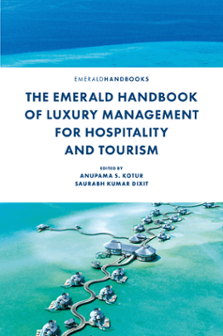
The Emerald Handbook of Luxury Management for Hospitality and Tourism
ISBN : 978-1-83982-901-7 , eISBN : 978-1-83982-900-0
Publication date: 25 January 2022
(2022), "Index", Kotur, A.S. and Dixit, S.K. (Ed.) The Emerald Handbook of Luxury Management for Hospitality and Tourism , Emerald Publishing Limited, Leeds, pp. 539-550. https://doi.org/10.1108/978-1-83982-900-020211035
Emerald Publishing Limited
Copyright © 2022 by Emerald Publishing Limited
We’re listening — tell us what you think
Something didn’t work….
Report bugs here
All feedback is valuable
Please share your general feedback
Join us on our journey
Platform update page.
Visit emeraldpublishing.com/platformupdate to discover the latest news and updates
Questions & More Information
Answers to the most commonly asked questions here
Accommodation
Government & Politics
Infrastructure
Environment
Research & Reports
Asia Pacific
North America
South America
Middle East & Africa

RealNZ focuses to low-volume, high-yield tourism
11th December 2023 By Staff Reporter | [email protected] | @tourismticker
Sorry, you do not have authorisation to view this page!
If you would like to view the content on this page you will need to be a Tourism Ticker member. Click here for our subscription packages.
As a tourism specific news site we work hard to bring you breaking and original content for the industry.
We value your support to make this happen!
Related Articles
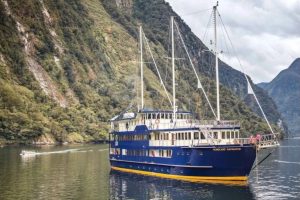
30 Jan 2024 RealNZ’s Navigator returns to service

26 Jan 2024 Inquiries launched into Doubtful Sound incident, RealNZ checks vessel damage
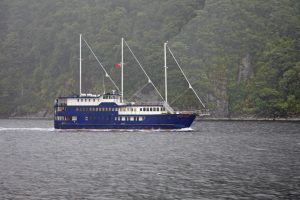
25 Jan 2024 Mayday after Fiordland vessel runs aground, passengers returned to land

16 Jan 2024 RealNZ, Pāmu support Mavora Explorer event
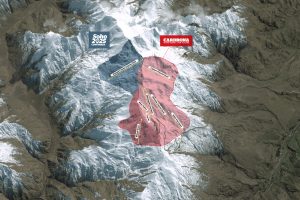
14 Dec 2023 Cardrona claims largest NZ ski area by 2025 with new chairlift

1 Dec 2023 RealNZ recognised for diversity, employee wellbeing

8 Nov 2023 Sustainable economy key focus for RealNZ – new CEO Dave Beeche

7 Nov 2023 RealNZ appoints CEO

19 Apr 2024 On the Job / People
On the job: cordelle’s new role, geopark hires gm, rtos’ contract china rep… and more, 19 apr 2024 immigration nz / tia / visas, inz breaks down top aewv changes for tourism operators, 19 apr 2024 hotels / str, weekly hotel results: wellington lifts off 2024 low, 19 apr 2024 ajhbnz, gallery: aj hackett bungy nz’s epicshot launch, 19 apr 2024 roundup, friday 19 april, 18 apr 2024 ajhbnz / apple, aj hackett bungy nz, apple launch epicshot to industry.
Home Roundup People Events Campaigns Transport Activities
Accommodation Government & Politics Infrastructure Māori Environment Technology
Data Research & Reports Features Resources Companies Jobs Market Calendar
China Australia Asia Pacific North America South America Europe Middle East & Africa
About Contact Newsletters
Advertise Sponsor Subscribe
NZ Media Council Privacy Policy Terms & Conditions
© 2024 Business Media Network Ltd Website by Webstudio
Academia.edu no longer supports Internet Explorer.
To browse Academia.edu and the wider internet faster and more securely, please take a few seconds to upgrade your browser .
Enter the email address you signed up with and we'll email you a reset link.
- We're Hiring!
- Help Center

Who is the ideal Tourist

Increasing attention is being given to identifying the characteristics of the ‘ideal tourist’. While no single definition has the support of all researchers, attributes of the ‘ideal tourist’ commonly advanced include features such as ‘high spending’, ‘responsible’, ‘caring’, ‘involved’, ‘environmentally aware’, ‘culturally sensitive’, ‘seeking meaningful social encounters’ and so on. It is argued that different economic measures serve different purposes, and in any case, are insufficient to specify the ‘ideal tourist’. A framework for identifying important social and environmental behaviours is presented which, taken together with economic measures, advance both the concept of the ideal tourist and its measurement into the ‘sustainability’ arena. Some potential evaluation techniques are discussed as are the underlying challenges to operationalise a concept of ‘sustainable yield’. The paper concludes with a discussion of the implications of the ‘ideal tourist’ concept for tourism planning and strategy.
Related Papers
Journal of Sustainable Tourism
Patrick T. Long
Journal of Responsible Tourism Management
J. Andres Coca-Stefaniak
This conceptual research article considers the concept of socially sustainable tourist behaviour. It explains the critical role of this behaviour in two parts (themes and behaviours), highlighting the lack of adequate research to date on this concept and the role of the social dimensions in achieving the UN’s Sustainable Development Goals (SDGs). The dimensions from previous works (academic and non-academic) attempting to articulate sustainable tourist behaviour from a social perspective are summarised and classified. A measurement framework of 19 dimensions of socially sustainable tourist behaviour is proposed. It is argued that the extant literature fails to comprehensively conceptualise and measure socially sustainable tourist behaviour, and that a new framework with an associated measurement scale is needed.
Mohamed Faarih
Research shows that despite their declared positive attitudes towards sustainable tourism, only a few tourists act accordingly by buying responsible tourism products, choosing environmentally friendly transportation or behaving responsibly towards destination communities. The low support from customers is one of the main barriers for progress towards sustainable tourism. One reason can be that existing initiatives are missing customers' attention, discouraging industry and governments to continue promoting sustainable tourism. Positive attempts to encourage sustainable consumption in other sectors indicate that specific barriers may reside in the nature of tourist choices. Taking a critical look at tourism research and literature, this article examines the interplay between reasons for tourists' choice of products and services, and environmental motivations. After identifying possible gaps that may explain current failures to stimulate responsible tourist choices, the article concludes by discussing the implications for the effectiveness of informative and awareness-raising tools aimed to facilitate the shift towards responsible tourist behaviour and actions.
Sustainability
Alvaro Dias
In a post-pandemic context, destinations are questioning mass tourism, and are focusing on more sustainable segments, looking for more responsible tourists. This requires obtaining relevant information to assess what kind of tourists visit the destination and, at the same time, to monitor changes in tourists’ behavior and attitudes. This study aims to respond to this challenge by creating a measure to assess the tourist’s responsibility. Using a scale development method, a sequential mixed-method approach is conducted to identify scale dimensions and items. An initial qualitative approach is implemented for item generation using focus group and face-to-face interviews. Then, a second study based on a survey is conducted for exploratory factor analysis. A third study, also based on a survey is performed to obtain a new sample for confirmatory factor analysis. Findings show two dimensions: civic responsibility and philanthropic responsibility, allowing an understanding of how tourists can act responsibly in destinations without compromising the ecological footprint on the planet. Theoretical and managerial implications are discussed.In a post-pandemic context, destinations are questioning mass tourism, and are focusing on more sustainable segments, looking for more responsible tourists. This requires obtaining relevant information to assess what kind of tourists visit the destination and, at the same time, to monitor changes in tourists’ behavior and attitudes. This study aims to respond to this challenge by creating a measure to assess the tourist’s responsibility. Using a scale development method, a sequential mixed-method approach is conducted to identify scale dimensions and items. An initial qualitative approach is implemented for item generation using focus group and face-to-face interviews. Then, a second study based on a survey is conducted for exploratory factor analysis. A third study, also based on a survey is performed to obtain a new sample for confirmatory factor analysis. Findings show two dimensions: civic responsibility and philanthropic responsibility, allowing an understanding of how tourists can act responsibly in destinations without compromising the ecological footprint on the planet. Theoretical and managerial implications are discussed.
Tourism Analysis
Derek Schofield
Ashift of attention from the dominant product orientation in environmentally sustainable tourism to a demand orientation has been suggested as a way of minimizing the effects of the inherent trade-offs the tourism industry faces between maximization of profits and investment in environmental sustainability. The success of such an approach depends on the existence of a class of tourists who are not only motivated to take care of the natural surroundings of the host destination, whether they are traveling in an ecotourism or general tourism context, but also represent an economically attractive market segment. The aim of this study is to investigate whether there is empirical evidence for the existence of such a segment among the wider tourism population and, if so, how can it be characterized and thus marketed to. Willingness to pay is used as a criterion to define this segment, as it implicitly accounts for the trade-off that suggests environmental protection comes at a price. Resul...
Environment-Behaviour Proceedings Journal
Chaima Touloun
Environmental sustainability is a significant issue nowadays. Travelers must become more environmentally conscious of protecting the earth. Academics focus more on environmental degradation, pollution, and human behaviour's influence on climate change. Late 20th-century researchers are increasingly environmentally conscious. Tourists' environmentally friendly conduct at their destination is influenced by contextual variables, although they have not been fully investigated. Researchers say studying visitor behaviour reduces tourism's environmental effect. By reviewing the literature, it is possible to contextualize the pro-environmental behaviour of tourists. Businesses, governments, and tourists must alter their practices to ensure a sustainable future. Keywords: Environmental behaviour; green tourism; tourist behaviour; sustainability eISSN: 2398-4287 © 2023. The Authors. Published for AMER ABRA cE-Bs by e-International Publishing House, Ltd., UK. This is an open access...
Tourism Management Perspectives
Paola Passafaro
This conceptual paper offers a theoretical and methodological analysis on the use of values for understanding and managing tourists’ environmentally sustainable choices. The aim is to provide a deeper discussion of the limits identified by recent reviews of the literature and to suggest additional ones. Moreover, we show how research in social and environmental psychology can help tourism scholars and practitioners to deal more effectively with them. Particular attention is paid to identifying the key aspects that characterize the different concepts and measures of values that are relevant to this topic. Suggestions for improving the effective use of this construct for research and management applications are provided. Possible avenues for consolidating, as well as broadening, the theoretical and practical foundations of this concept’s use in the domain of tourists’ sustainable behaviour are also discussed.
Tourism and Hospitality Research
ABSTRACT This paper reports the results of two exploratory studies (overall N=532) which aimed at drawing the profile of the ‘sustainable tourist’ (a person committed to respect the sustainability principles when on holiday) in terms of personal values, attitudes and personality traits, following an environmental psychology approach. More specifically, study 1 explored the role of Attitudes Towards Sustainable Tourism (ATST), Affinity Towards (social and environmental) Diversity (ATD), and personal values, while study 2 assessed the role of the Big Five personality traits in the prediction of preferences for sustainable and unsustainable tourist activities. Results indicate that biospheric values, positive attitudes towards sustainable tourism, and higher levels of affinity towards diversity are able to predict more sustainable tourism choices while personality traits seemed to play a more indirect and complex role.
Ecological Economics
Susanne Becken
Begum AYDIN
Considering the tourists' viewpoint when creating a sustainable destination is crucial since marketing may be the driving force behind many sustainability initiatives. However, most of the literature has followed a supply-based perspective, ignoring the way that tourists view sustainability attributes. Therefore, this research attempts to address this gap in the literature by analyzing tourists' perceptions concerning sustainability attributes in tourist destinations. This research aims to determine which of these traits are seen as most important by the tourists and to ascertain their willingness to pay for these aspects. The study is quantitative, based on an online questionnaire administered to Turkish cultural tourists. Exploratory and confirmatory factor analyses are used to obtain insights into how tourists consider sustainability aspects in tourist destinations. Thus, this research concludes that tourists view sustainability from a more varied perspective than that embraced by the classic definition of the concept, which comprises economic, environmental and socio-cultural dimensions. The findings of the study also determine that tourists favor sustainability attributes that are instrumental in enhancing their own tourist experiences. This information may be useful for destinations, providing guidance about how to market sustainable tourist destinations and encourage responsible tourism choices.
How new initiatives are protecting the Galápagos for future generations
The new Hermandad marine reserve is the latest conservation initiative to bring vital protection to the pristine waters of The Galápagos islands.
It’s night aboard the Santa Cruz II and the Pacific Ocean thrashes with endemic Galápagos sharks. Using our ship’s lights, we watch the creatures below hunt flying fish with quicksilver agility, some of the hapless prey crashing into our vessel’s hull, around which sea lions wait for an easy meal. A huge green turtle pops up unawares amid the melee, before swiftly returning to the depths. Such is the Galápagos’s scintillating theatre.
The Galápagos Islands (a national park since 1959) can thank large upwellings of cold currents for their staggering marine biodiversity; water that ushers in a rich soup of nutrients, helping to support a food web that contains abundant marine and terrestrial wildlife — a large proportion of which is found nowhere else on Earth. It was this uniqueness that the British naturalist Charles Darwin observed soon after stepping ashore on San Cristóbal Island in 1859, setting him on a path to publishing On the Origin of Species, which outlined his groundbreaking theories on evolution.
Fast forward to 2020, and some of those charismatic creatures — including the sharks I encounter under our ship — are being netted by a huge Chinese fishing fleet not far outside the Galápagos Marine Reserve (GMR), a 53,000sq mile protected marine habitat created in 1998. With Galápagos marine wildlife already subject to food shortages during intensifying El Niño events, such industrial overfishing — a threat to both conservation efforts and tourism — prompted the Ecuadorian government to expand the existing marine reserve. This year, in January it created the 23,000sq mile Hermandad Marine Reserve.
“The Galápagos Islands are one of the best-kept national parks in the world,” says Roque Sevilla. As chairman of Metropolitan Touring , Ecuador’s first carbon-neutral tour operator, he was one of the primary movers behind the new reserve. “Just think of an African national park with a dozen vehicles surrounding a lion,” he says. “Here, only one boat at a time can enter a landing point on an island, and groups are limited to 16 per guide.”
Roque says tourism has been a positive force for the Galápagos: funding conservation, providing 80% of the islands’ economy, and jobs for born-and-bred Galapagueños. Tourism is well controlled, he believes. “There’s a de facto limit to the number of visitors who can sail here, with a fixed 1,690 berths on all ships per day, and this quota hasn’t changed since 1998,” he says. Likewise, human migrations onto the islands are strictly controlled. Visitors currently pay a $100 (£81) fee to enter the Galápagos National Park, which funds its activities. Its director, Danny Rueda-Cordova, says this may be increased to refocus on low-number/high-yield tourism. He says visitor numbers fell from a record 270,000 in 2019 to half that in 2021 at the peak of the pandemic. Because most of them were Ecuadorians (who just pay a $6/£4.90 entry fee), revenues fell, affecting funding.
Other challenges facing the Galápagos include intensifying El Niño episodes triggered by global ocean warming. This natural phenomenon becalms the usually strong equatorial trade winds that push warm water westwards away from the Galápagos, allowing upwelling cold currents to deliver rich phytoplankton into the food web. During an El Niño event, nutrient productivity in warmer water drops dramatically, triggering starvation among key marine species.
In addition, certain invasive species introduced by humans, such as fruit flies and rats, have pushed a number of creatures to the brink. One of Darwin’s evolutionary miracles, the mangrove finch, is near extinction due to the accidental introduction of the sinister-sounding avian vampire fly in the 1960s. In June 2020, a new threat loomed: a fleet of 300 Chinese trawlers had assembled just outside the GMR.
New reserves
The writing had been on the wall. In 2017, the Fu Yuan Yu Leng 999 was seized after straying inside the GMR. This ‘nanny ship’ (a refrigeration vessel) was carrying 300 tonnes of illegally caught species, including 7,639 sharks. Twenty crew members were jailed and the vessel was confiscated by Ecuador after the non-payment of a $6.1m (£5m) fine.
Then, in 2020, the 300-strong trawler fleet began fishing intensively, clocking up 73,000 hours in one month alone. It fished heavily for squid, a key food source for many Galapagueños species, but also pulled out migratory hammerhead sharks and manta rays. The presence of the Chinese fleet caused consternation amid Galapagueño fishermen, who complained their own catches were down.
More safeguarding was needed. “Fish don’t understand whether they’re swimming in a safe reserve or not,” says Gustavo Manrique, Ecuador’s minister of the environment. The new Hermandad reserve — a vast area, the size of Sri Lanka, extending north of the previous GMR — will create a migration corridor from the Galápagos to the Cocos Islands National Park in Costa Rica. All fishing will be banned in 50% of the reserve, with only Galapagueño fishermen allowed to operate in the other half, although longline fishing (which doesn’t discriminate between target fish and vulnerable species) is banned. Hermandad forms part of a groundbreaking multinational agreement with Costa Rica, Panama and Colombia, which have similar ocean reserves totalling 193,000sq miles, to expand the existing Eastern Tropical Pacific Marine Corridor. “The marine corridor between Ecuadorian and Costa Rican waters creates a safe migration for important endangered species,” say Gustavo Manrique.

“It’s a critical step in protecting some 3,000 marine Galápagos species, of which 20% are endemic.” Marine reserves also encourage sustainable fishing and tourism.
“A shark’s net worth to our economy if it lives 20 years is $1.5m. But a dead one, $137 for meat. It creates business around ecological tourism,” says Manrique. Modern technology, he says, will make enforcement and monitoring easier and cheaper. “We can use drones, satellites and small, fast enforcement boats,” he explains.
Ecuador is now using technology that can detect ‘dark vessels’ (ships with their tracking systems turned off). As for funding, The country is carrying out ‘debt for nature’ swaps, restructuring their national debts owed to donor nations in return for conservation investment. “We negotiate as a poor country, but the new global richness is biodiversity,” says Manrique.

Tourism’s role
It’s too early to access the impact of the new reserve. But María-José Barragán, science director at the Charles Darwin Research Station on Santa Cruz Island, is certain it will be beneficial. “This corridor ensures species will be protected during migration to the Galápagos, which will contribute to the local economy through sustainable fishing and wildlife tourism”. Ecuador’s minister for tourism, Niels Olsen, says his government has a vested interest in ensuring the reserve is a success. “Tourists will not come if they think we’re not working towards conserving and protecting the islands.”
When I visited, public opinion about the new reserve seemed positive on Santa Cruz Island, where much of the Galápagos’s 25,000-strong population lives, mainly in the town of Puerto Ayora. It’s a tourism hub of hotels, bars, restaurants and souvenir emporiums, where sea lions doze on public benches and pelicans harangue fishermen for scraps.
“Our fish rotate between feeding grounds outside the reserve. Our fishermen were saying their catch was down when the Chinese boats were here,” says local merchant, Mercy Sancan. “Since their boats left, the fish seem more numerous.”
Marcia Garate, a local travel agent, also supports the creation of Hermandad. “The reserve is good for us because we don’t want to lose our grouper and tuna as animals such as sea lions need them. Tourists won’t come if we lose our wildlife.”
And come, tourists do; a trip to these islands represents the wildlife experience of a lifetime. There are two ways to experience the archipelago: either on a cruise ship or as part of a day trip on a boat. Cruises typically range from five to 11 days and include a stop at Santa Cruz, with some focusing on the western islands, including Isabela, with its penguins and flightless cormorants. Others take in the eastern group, including San Cristobal, home to red-footed boobies. Longer voyages, meanwhile, will cover both areas. Cruises include twice-daily land excursions with snorkelling, while liveaboard cruise vessels focus on scuba diving. The budget-conscious can find accommodation on Santa Cruz and head out on boat day trips or island-hop.

My experience at sea saw me spending six nights exploring the eastern islands on board Santa Cruz II, Hurtigruten’s debut Galápagos cruise, which uses a Metropolitan Touring vessel that hosts up to 90 guests.
During shore visits with the ship’s naturalists, we encounter playful sea lions on the Mosquera sand bar and spend time with the land iguanas basking by cactus trees on tiny Santa Fé Island, the only place in the world these iguanas exist. Birding highlights are many: nesting colonies of frigate birds on North Seymour Island, the males with expanded, cherry-red crops, and a Nazca booby with fluffy, snowball-white chicks on Española Island. And sublime snorkelling experiences include the chance to swim for 20 minutes at a time with a giant Galápagos green turtles and whitetip reef sharks. On Santa Cruz, we visit a Giant Tortoise Restoration Initiative to learn how the creature’s diversity across different islands informed Darwin’s theories on evolution.
The responsibility to protect these hallowed shores can weigh heavy on visitors. But from the smallest actions and decisions, personal responsibility can count towards making the Galápagos a sustainable destination. “Every tourist must reflect on how to lower their carbon footprint,” says Gustavo Manrique. “Sure, you can eat salmon flown in from Chile, or instead choose local fish, like brujo [scorpion fish], fished in these waters, so money stays local.”
Such simple actions as reusing a water bottle, avoiding single-use plastic and taking non-recyclable waste off the islands when departing should be part of the modern traveller’s toolkit. But what about the bigger picture? For example, how to mitigate air travel’s effect on the climate, which is critical to fragile ecosystems such as those in play on the Galápagos Islands. The reality is we probably need to fly less, yet tourism to the Galápagos is critical to funding its conservation.
Metropolitan Touring is a carbon-neutral operator in the region.“Our core value is to take action against our carbon footprint and finance conservation,” says Carolina Proaño-Castro, executive director of Fundación Futuro , the nonprofit organisation that’s helped Metropolitan Touring work towards becoming carbon neutral. All aspects of its Galápagos cruises are examined for carbon efficiency, from using anti-corrosive paint to deter crustacean build-up on ships, thus improving fuel efficiency, to giving guests reusable metal water bottles.
Guests pay a levy calculated at $16 (£13) per tonne of carbon, which funds a tangible conservation initiative: the conservation of a 6,670-acre reserve at Mashpi Lodge in Ecuador’s Chocó-Andino cloud forest area. The levy is also being used to help establish a biological corridor in the Chocó-Andino by buying up more forest to conserve, enabling landowners to follow more sustainable practices.
“Just as Galápagos sharks need a migration corridor to avoid being fished, connectivity is the key to climate change adaptivity all over the world,” says Proaño-Castro.
Five to try: Marine Protected Areas (MPAs)
1. Ross Sea Region The world’s largest MPA borders Antarctica, spanning 618,000sq miles. It administers ‘no-take’ and sustainable fishing zones and is home to 30% of the world’s Adélie penguins and a third of its Antarctic petrels.
2. Pitcairn Islands Covering a colossal 322,000sq miles, the Pitcairn Islands MPA extends south east from the Pitcairn Islands. The 47 inhabitants of the only inhabited island, Pitcairn, are descendants of the mutinous HMS Bounty crew. Commercial activities are forbidden in its waters, home to sharks and cetaceans.
3. Ascension Island Right out in the mid-Atlantic, this MPA surrounds the giant undersea volcano of Ascension Island, a 172,000sq-mile home for marlin and significant green turtle populations.
4. South Georgia and the South Sandwich Islands Spanning 479,000sq miles of sub-Antarctic waters, this MPA supports blue whales and penguins; fishing is outlawed in a quarter of its waters.
5. Papahānaumokuākea Home to coral atolls that protect endemics including Hawaiian monk seals, this 579,000sq-mile reserve in the North Pacific also hosts key native cultural sites.
How to do it
Hurtigruten Expeditions has an 11-day expedition cruise to the Galápagos Islands on a full-board basis. It includes three nights at Casa Gangotena hotel in Quito, all transfers and flights, a cultural tour of Quito and a nature tour of Cotopaxi National Park, from £7,595 per person, based on two sharing.
More information
A double room at Mashpi Lodge , a cloud forest hotel in mainland Ecuador costs from £1,074 per night, including shared transfers and all meals, guided activities and excursions within the reserve.
Published in the September 2022 issue of National Geographic Traveller (UK)
Follow us on social media
Twitter | Facebook | Instagram
Related Topics
- ADVENTURE TRAVEL
- ENVIRONMENT AND CONSERVATION
You May Also Like

Where to travel in Malaysia: three trips to suit your travel style

The travel kit list: the best gear for rainforest hiking
Free bonus issue.

How to spend a weekend in the Lake District

The ultimate Andes road trip, from Chile to Bolivia

Swastika Mountain needed a new name. Here’s how it got one.

Banff, Jasper and more: 4 wild places for Canadian outdoor adventures

Photo story: a portrait of Namibia's Kunene region, home to desert wildlife and star-studded skies
- Perpetual Planet
- Environment
- History & Culture
- Paid Content
History & Culture
- Mind, Body, Wonder
- Terms of Use
- Privacy Policy
- Your US State Privacy Rights
- Children's Online Privacy Policy
- Interest-Based Ads
- About Nielsen Measurement
- Do Not Sell or Share My Personal Information
- Nat Geo Home
- Attend a Live Event
- Book a Trip
- Inspire Your Kids
- Shop Nat Geo
- Visit the D.C. Museum
- Learn About Our Impact
- Support Our Mission
- Advertise With Us
- Customer Service
- Renew Subscription
- Manage Your Subscription
- Work at Nat Geo
- Sign Up for Our Newsletters
- Contribute to Protect the Planet
Copyright © 1996-2015 National Geographic Society Copyright © 2015-2024 National Geographic Partners, LLC. All rights reserved
Compare the Best Bank Accounts for International Travel
Best bank accounts for international travel reviews, introduction to banking for international travel.
- Key Features
- Additional Services and Tips
- Why You Should Trust Us
Best Banks for International Travelers for April 2024
Affiliate links for the products on this page are from partners that compensate us and terms apply to offers listed (see our advertiser disclosure with our list of partners for more details). However, our opinions are our own. See how we rate banking products to write unbiased product reviews.
If you're an avid traveler at heart, then your bank account should reflect that.
We looked for the best savings accounts that may help you save for travel and checking accounts that allow you to access your money with ease when you're on the road and overseas.
Top Bank Account for International Travel Benefits
Ally Savings Account
Bask Bank Mileage Savings Account
Capital One 360 Checking
Schwab Bank High Yield Investor Checking® Account
SoFi Checking and Savings
Revolut Account
Below, you'll see our top picks for international travel. All of the financial institutions on our list are protected by FDIC or NCUA insurance. Money is safe at a federally insured financial institution. When an institution is federally insured, up to $250,000 per depositor is secure in a bank account.
Compare Today's Savings Rates
Earn 4.20% Annual Percentage Yield with a $0 minimum account opening requirement
no monthly service fee
- Check mark icon A check mark. It indicates a confirmation of your intended interaction. High APY
- Check mark icon A check mark. It indicates a confirmation of your intended interaction. No minimum opening deposit
- Check mark icon A check mark. It indicates a confirmation of your intended interaction. No monthly service fees
- Check mark icon A check mark. It indicates a confirmation of your intended interaction. Savings buckets help you save for different goals
- Check mark icon A check mark. It indicates a confirmation of your intended interaction. Surprise savings transfers help you save extra money from your checking account
- con icon Two crossed lines that form an 'X'. No physical branch locations
- con icon Two crossed lines that form an 'X'. No way to deposit cash
The Ally High Yield Savings Account is a great option for anyone who wants savings tools to help save for specific financial goals, or prioritizes an account that doesn't charge standard bank fees.
- Create separate savings buckets in a savings account
- Link to your Ally checking account and enroll in surprise savings transfers to have extra money transferred to savings three times per week
- Interest compounded daily, paid monthly
- FDIC insured
Earn up to 10,000 bonus AAdvantage® miles for new Bask Mileage Savings Account customers who open and fund their account within 15 business days from account opening and maintain a minimum daily balance of $50,000 for 90 consecutive days out of the first 120 days (open account by May 31, 2024)
up to 10,000 bonus AAdvantage® miles
- Check mark icon A check mark. It indicates a confirmation of your intended interaction. Earn American Airlines AAdvantages miles
- con icon Two crossed lines that form an 'X'. May not be easy to deposit cash
The Bask Bank Interest Savings Account and Bask Bank CD are excellent options if you'd like to earn a high interest rate. The Bask Bank Mileage Savings Account may be a great choice if you frequently use American Airlines for travel. Bask Bank doesn't offer a checking account, though.
- Earn up to 10,000 Bonus AAdvantage® miles. To qualify for this offer, you must be a first time Bask Mileage Savings Account customer, open a Bask Mileage Savings Account between March 1, 2024 and May 31, 2024, fund your Bask Mileage Savings Account within 15 business days following the initial account opening and maintain a minimum daily account balance of $50,000 for 90 consecutive days out of the first 120 days following the initial account opening.
- Earn 2.5 American Airlines AAdvantage miles for every $1 saved annually on a Bask Bank Mileage Savings Account
- Must provide your AAdvantage account number to receive AAdvantages miles
- AAdvantage miles earned through the Bask Mileage Savings Account can't be used toward boosting your American Airlines elite status
- Miles awarded monthly
- Deposits FDIC insured through Texas Capital Bank
No minimums, no fees, no worries.
See website for details
- Check mark icon A check mark. It indicates a confirmation of your intended interaction. Earn interest on all account balances
- Check mark icon A check mark. It indicates a confirmation of your intended interaction. No opening deposit or minimum account balance
- Check mark icon A check mark. It indicates a confirmation of your intended interaction. No monthly service fee
- Check mark icon A check mark. It indicates a confirmation of your intended interaction. No foreign transaction fee
- Check mark icon A check mark. It indicates a confirmation of your intended interaction. Range of overdraft protection options
- Check mark icon A check mark. It indicates a confirmation of your intended interaction. Processes direct deposits up to 2 days early
- con icon Two crossed lines that form an 'X'. Doesn't reimburse out-of-network ATM fees
- con icon Two crossed lines that form an 'X'. Limited access to customer service by phone
Capital One is a strong bank overall. You'll earn competitive interest rates on online savings accounts and CDs.
- Over 70,000 free ATMs nationwide
- Branches in NY, LA, TX, MD, VA, NJ, and Washington, DC
Earn 0.45% Annual Percentage Yield (APY). $0 minimum deposit. FDIC Insured.
- Check mark icon A check mark. It indicates a confirmation of your intended interaction. No opening deposit
- Check mark icon A check mark. It indicates a confirmation of your intended interaction. No minimum account balance
- Check mark icon A check mark. It indicates a confirmation of your intended interaction. Unlimited out-of-network ATM reimbursements
- Check mark icon A check mark. It indicates a confirmation of your intended interaction. No foreign transaction fees
- Check mark icon A check mark. It indicates a confirmation of your intended interaction. Free overdraft protection
Charles Schwab Bank is one of the best banks for international travelers, because it doesn't charge foreign transaction fees. It also refunds all fees charged by ATMs worldwide. But if you want to earn high interest rates, you're better off looking elsewhere.
- 24/7 live online chat
- When you open a checking account, you automatically open a Charles Schwab brokerage account, too
- No ATM network, but unlimited ATM fee reimbursements
Earn up to a $300 bonus with qualifying direct deposits for eligible customers through 6/30/24. Earn up to 4.60% APY on savings balances (including Vaults) with direct deposit
up to 4.60%
- Check mark icon A check mark. It indicates a confirmation of your intended interaction. FDIC insured for $2 million
- Check mark icon A check mark. It indicates a confirmation of your intended interaction. High interest rate
- Check mark icon A check mark. It indicates a confirmation of your intended interaction. Earn a higher interest rate with qualifying activities
- Check mark icon A check mark. It indicates a confirmation of your intended interaction. No overdraft fees
- Check mark icon A check mark. It indicates a confirmation of your intended interaction. Up to $300 bonus with qualifying direct deposit (terms apply)
- Check mark icon A check mark. It indicates a confirmation of your intended interaction. No-fee overdraft coverage if you overdraw up to $50
- Check mark icon A check mark. It indicates a confirmation of your intended interaction. Savings tools
- Check mark icon A check mark. It indicates a confirmation of your intended interaction. Early direct deposit
- Check mark icon A check mark. It indicates a confirmation of your intended interaction. Joint account available
- con icon Two crossed lines that form an 'X'. Declined purchase if you overdraw by more than $50
- con icon Two crossed lines that form an 'X'. Doesn't reimburse out-of-network ATM providers' fees
- con icon Two crossed lines that form an 'X'. May deposit cash at Green Dot locations but there's a $4.95 fee
SoFi Checking and Savings is a great account option if you don't mind keeping your savings and checking in one account.
- FDIC insured for $2 million
- Free access to 50,000+ Allpoint ATMs worldwide
- Hybrid checking/savings account
- Earn 4.60% APY on savings balances (Vaults included) and 0.50% APY on checking balances if you set up direct deposit or deposit minimum $5,000 per month
- Earn 1.20% APY on SoFi Checking and Savings if you don't have qualifying activities
- Earn up to $300 cash bonus available through June 30, 2024; receive a $50 bonus if you make a direct deposit between $1,000 and $4,999 in the first 30 days of opening an account; receive a $300 bonus if you make a direct deposit of $5,000 or more in the first 30 days of opening an account
- Create up to 20 Money Vaults to save for individual savings goals like an emergency fund or vacation
- $4.95 fee each time you deposit cash at a Green Dot location
- To get no-fee overdraft coverage you must have at least $1,000 in direct deposits
no monthly service fees on Standard plan
Standard plan: up to 3.25% APY, Premium plan: up to 4.25% APY, Metal plan: up to 4.25% APY
- Check mark icon A check mark. It indicates a confirmation of your intended interaction. No monthly service fees on Standard plan
- Check mark icon A check mark. It indicates a confirmation of your intended interaction. Prepaid debit card included (specific card depends on monthly plan)
- Check mark icon A check mark. It indicates a confirmation of your intended interaction. Spend abroad in over 140 currencies
- Check mark icon A check mark. It indicates a confirmation of your intended interaction. Budgeting features
- Check mark icon A check mark. It indicates a confirmation of your intended interaction. Withdraw up to $1,200 from out-of-network ATMs on Metal plan with no fair usage fees
- con icon Two crossed lines that form an 'X'. Can't overdraw from account
- con icon Two crossed lines that form an 'X'. 2% fee of ATM withdrawal on out-of-network ATM fees if you exceed the limit
- con icon Two crossed lines that form an 'X'. $0.30 to $6 international money transfer fee if you exceed limit
- Access to 55,000 free ATMs through the Allpoint ATM network
- Withdraw up to $1,200 from out-of-network ATMs on Metal plan
- Spend in more than 140 currencies
- Additional international wire transfer fees will depend on the transfer amount and whether there's a currency exchange
- Banking services are provided by Metropolitan Commercial Bank, Member FDIC
Compare Today's Banking Offers
Best Bank Accounts for International Travel FAQs
Charles Schwab is our top pick for international ATM access. It offers unlimited refunds for ATM fees worldwide.
To minimize fees when using a bank card abroad, you want to limit making ATM withdrawals unless you find an ATM that's in your network. Some debit cards also have foreign transaction fees, so it's best to use cash or one of the best credit cards with no foreign transaction fees .
Yes. Many banks and credit unions pay good rates to exchange foreign currency. Most financial institutions will require you to have a bank account with them in order to exchange currency , though.
Yes. Some banks offer travel insurance if you get a credit card with features like travel accident insurance and trip delay reimbursements.
Yes. You should call your bank before traveling so you're well prepared. If you forget to contact your bank, your debit card may be denied when you make purchases to protect you from potential fraudulent activity.
Yes. You may open a bank account in another country. However, make sure that you report your bank account information to the IRS annually .
Best Savings Accounts for International Travel
The Ally High Yield Savings Account provides easy tools to set savings goals for your next trip, and you'll earn interest without having to take on any risk.
You can also set up a checking account through Ally . When you need access to your savings, just transfer money from the savings account to the checking account through the online portal, and you'll be able to spend the money almost instantly.
Ally also offers an easy-to-use mobile app and 24/7 customer support, making it simple to access your account while you're on the road.
You won't be able to deposit cash directly into your bank account. Instead, you'll have to transfer money from another bank account.
Ally Savings Account Review
You might find the Bask Bank Mileage Savings Account appealing if you are a frequent American Airlines flyer. This savings account lets you earn earn 2.5 American Airlines AAdvantage miles for every $1 saved annually on a Bask Bank Mileage Savings Account. You can redeem miles for booking flights or hotels, upgrading flights, renting transportation, or planning vacation activities.
Bask Bank is also offering a savings account bonus for new customers: earn up to 10,000 bonus AAdvantage® miles for new Bask Mileage Savings Account customers who open and fund their account within 15 business days from account opening and maintain a minimum daily balance of $50,000 for 90 consecutive days out of the first 120 days (open account by May 31, 2024)
AAdvantage miles earned through the Bask Bank Mileage Savings Account will not go toward boosting your AAdvantage status.
Bask Bank also doesn't have a checking account, ATM cards, or debit cards, so you'll have limited access to your account. You'll need to link an external bank account and initiate a bank transfer to deposit or withdraw money.
Bask Bank Review
Best Checking Accounts for International Travel
Capital One 360 Checking might be a solid choice if you're most comfortable with a well-known retail bank and want no-fee cash withdrawals at home and in select countries abroad.
You can withdraw up to $1,000 a day at any ATM worldwide using your MasterCard and Capital One won't charge a fee, though the ATM operator may. The bank ranks No. 1 on J.D. Power's US National Banking Satisfaction Study , and it made Business Insider's list of the best checking accounts.
Capital One also offers a solid high-yield savings account, which is a good choice if you want to keep your savings at the same bank as your checking.
If you travel to Europe, Asia, or any other place where Capital One and AllPoint don't have ATMs, you may have to pay third-party ATM operator fees to take cash out (Capital One will never charge you an additional fee).
As for branch access, the bank only operates about 280 branches in seven US states, though Capital One Cafés are in some big cities around the US.
Capital One 360 Review
Charles Schwab is an investment platform, but it also has banking products. The Schwab Bank High Yield Investor Checking® Account is a great choice if you'd like a fee-free international spending bank account. It notably offers unlimited refunds for ATM fees worldwide, and it doesn't charge foreign transaction fees.
You must open a brokerage account with Charles Schwab before opening a checking account, though.
Charles Schwab Bank Review
Best All-in-One Accounts for International Travel
SoFi Checking and Savings offers the best of both worlds. It's a hybrid savings/checking account with a competitive interest rate and a MasterCard debit card for easy access to your cash.
SoFi is part of the Allpoint ATM network, so you have free access to 50,000 ATMs worldwide, and SoFi doesn't charge a foreign transaction fee when you make a purchase with your debit card abroad.
Again, SoFi is completely online — you'll need to call customer service when you want help with your account rather than walking into a physical location.
While SoFi doesn't charge any foreign transaction fees when you withdraw cash at an international bank or ATM, MasterCard will charge 0.20%, and SoFi won't reimburse you.
SoFi Checking and Savings Review
You might like the Revolut Account if you're looking for an alternative to traditional banking.
Revolut is a British fintech company with an international finance and investing app. You can open accounts from anywhere in the US.
The Revolut Account is a prepaid debit card linked to a bank account. You can easily spend money internationally in over 150 types of currency. The account also allows you to make one fee-free international or domestic wire transfer per month with the Standard plan, three with the Premium plan, and five with the Metal plan.
The account also has budgeting features that let you round up prepaid debit card purchases or set up individual savings goals through Vaults. The Revolut Account and Savings Vault are FDIC-insured by Metropolitan Commercial Bank and Sutton Bank.
Revolut has three plans: Standard (Free), Premium ($9.99 per month), or Metal ($16.99 per month). Access to certain app features will depend on your monthly plan.
Revolut Review
Bank Account Alternatives for Travelers
- Chase Total Checking® : This account appeared on our best checking accounts list, but it charges $3 fee per withdrawal at a non-Chase ATM in the U.S., Puerto Rico and the U.S. Virgin Islands. Surcharge Fees from the ATM owner/network still apply. $5 fee per withdrawal at a non-Chase ATM outside of the U.S., Puerto Rico and the U.S. Virgin Islands. Surcharge Fees from the ATM owner/network still apply.
- Discover® Cashback Debit Account : Discover's checking account has no monthly service fees and allows you to earn 1% cash back on up to $3,000 in debit card purchases every month (see website for details), but its use is limited to the US, Canada, Mexico, and the Caribbean.
- Citi Regular Checking : A fine checking account with options to waive the $15 monthly service fee and branch locations abroad, but customer satisfaction is below average, according to J.D. Power's US National Banking Satisfaction Study .
- HSBC Premier Checking : HSBC (Member FDIC) offers a good variety of checking accounts, although only those with high minimum balance or deposit requirements get ATM fees reimbursed.
- Wealthfront Cash Account : Although this account operates similarly to a high-yield savings account, it's technically a cash management account. You might like this option if you already invest with Wealthfront and want to earn a high interest rate on your savings. However, keep in mind Wealthfront doesn't offer other types of accounts like CDs or checking accounts.
- Betterment Checking Account : Betterment reimburses all foreign transaction fees and ATM fees worldwide, and the app is easy to use. However, our top picks for checking accounts may also offer more banking options, such as CDs or brokered CDs.
- Marcus High Yield Online Savings Account : Marcus has a good high-yield savings account; Marcus savings rates current pays 4.40% APY. However, the high-yield savings account doesn't have as many goal-setting features as Ally, if that's important to you.
- American Express® High Yield Savings Account (Member FDIC): With a solid savings rate, this high-yield savings account is a good option if you don't mind not having mobile access.
When you're traveling abroad, bear in mind many financial institutions have fees for using a debit card internationally.
For example, if you use an ATM provider to withdraw money that isn't in your network, you may have to pay out-of-network ATM fees from the provider and your financial institution.
Many banks also have foreign transaction fees. A foreign transaction fee is a debit or credit card charge that can happen when you buy something internationally and it needs to be processed through a foreign financial institution.
There are many financial institutions that can help you avoid common international bank fees, though.
Key Features of Ideal Banks for International Travel
The right bank can make saving for travel goals easier. It can also help you avoid common bank fees, like out-of-network ATM and foreign transaction fees. Below, we've highlighted key features among the top banks for multi-country travel.
Competitive Savings Rates
One key feature to look for in a bank is a competitive savings rate. High-yield savings accounts, in particular, can be strong banking options because they offer better rates than traditional savings accounts. These bank accounts might also be a good choice if you want to set savings goals for specific travel trips. Money in a high-yield savings account can deposited at any time, so you can contribute to a travel goal in stages. If you open a high-yield savings account at an online bank, you also usually won't have to worry about dealing with monthly service fees.
Exchange Rates
If you want to have cash on hand during a trip, it may be beneficial to bank with a financial institution or platform that offers straightforward foreign exchange services. Banking institutions usually offer better exchange rates than airport exchange services or on-site travel spots.
Low Foreign Transaction Fees
If you plan on using a debit card or credit card frequently, make sure to look for a bank that has low foreign transaction fees. That way, you won't have to worry about fees piling up when you use your card to buy things abroad.
Some financial institutions on our list, like SoFi, do not charge foreign transaction fees.
Wide Global ATM Network Accessibility
If you want to use an ATM abroad, the best option is to find a national bank with a global ATM network or one that provides reimbursements for out-of-network ATM fees. Charles Schwab, for example, offers unlimited worldwide ATM fee reimbursements.
Additional Services and Tips for International Banking
If you're planning on traveling abroad soon, it's best to be prepared beforehand so you can avoid unnecessary stress. Sometimes, credit or debit cards may not work if you don't give your bank notice that you're traveling. This is done as a measure to protect you against fraudulent activity. To avoid having your card declined internationally, make sure to call your financial institution before traveling so you can make sure it works during the time you're abroad.
It's also helpful to have cash on hand when traveling in case you need it for an emergency situation. Experts recommend getting foreign currency before you begin travel because airports and on-site currency exchange locations tend to involve more costly service fees and unsatisfactory exchange rates.
Bank Trustworthiness and BBB Ratings
The Better Business Bureau assesses companies based on responses to customer complaints, honesty in advertising, and transparency about business practices. Here are the BBB grades for our favorite travel accounts:
Revolut has an F rating from the BBB due to a high volume of customer complaints filed against the business, and Revolut hasn't responded to or resolved some of the complaints.
Bask Bank received a B grade from the BBB because of its volume of customer complaints. However, its parent company, Texas Capital Bank, has an A+ rating from the BBB.
A great BBB score doesn't guarantee your relationship with a company will be perfect. You'll also want to speak with current customers or read online customer reviews.
Capital One is the only bank on our list that has been involved in a recent public controversy. Capital One used to have an account called 360 Savings. In 2019, the bank launched the new 360 Performance Savings Account, which paid a much a higher interest rate. Many customers thought their old savings accounts would transition into this new one, but in reality, they had to manually open a new 360 Performance Savings Account to earn the higher rate. So some customers have been earning a significantly lower savings rate for years.
In the lawsuit, the plaintiffs' lawyers allege that Capital One didn't inform 360 Savings customers that these were two distinct accounts, or that 360 Performance Savings paid a higher rate. However, Capital One wants this case dismissed because it claims people had every opportunity to learn these facts on their own. This case is still ongoing.
Why You Should Trust Us: Our Expert Panel for the Best Banks for International Travel
We consulted banking and financial planning experts to inform these picks and provide their advice on finding the best accounts for your needs.
Here's what they had to say about banking for travel. (Some text may be lightly edited for clarity.)
How can someone determine whether a bank is the right fit for them?
Tania Brown, certified financial planner and vice president of coaching strategy at OfColor :
"Obviously, you want to make sure it's FDIC insured. Also, your banking experience — do you like walking into a bank? Well, then you need someone local. Do you just not care if you ever see your bank? Then you're okay online. Do you write checks? Do you not write checks? So it's thinking through how your experience with it is going to be before you make that decision."
Sophia Acevedo, banking editor, Business Insider :
"I would create a list of what I prioritize most in a bank account. For example, some banks have accounts that charge monthly service fees. I would look to see what the requirements are for waiving the monthly service fee and whether I think I could feasibly meet those requirements each month. If I'm searching for an interest-earning bank account I'll pay attention to interest rates. I would make sure the account pays a higher interest rate than the average bank account ."
What should someone look for in an online bank?
Roger Ma, certified financial planner with lifelaidout® and author of "Work Your Money, Not Your Life" :
"How onerous the transfer process is, transferring money in and transferring money out. Is it same day, next day? Is it pretty easy to sync a brick-and-mortar checking account to this particular high-yield savings account?"
Mykail James, MBA, certified financial education instructor, BoujieBudgets.com :
"When it comes to online banks, you want to be a little bit more strict about what type of interest rates they're providing. That's the biggest thing, because online banks are supposed to have the higher interest rate because they don't have the overhead of the brick-and-mortar. You want to make sure that it's well above the national average.
"What types of securities do they provide? Do they have two-factor identification? If it's an online bank, they should definitely have — at the bare minimum — two-factor authentication in how easy it is to change your passwords and things like that, because you want to be a little more hypersensitive about the cyber security for a strictly online bank."
What should someone look for in a bank account if they travel frequently?
Sophia Acevedo:
"You'll want to be mindful of bank account limits and fees. You might be charged fees if you use an ATM from another bank. Banks and credit unions also have limits on how much you can withdraw from your ATM each day. When you're looking for a bank account, see if your bank provides refunds for out-of-network ATMs and what the ATM withdrawal limits are."
Methodology: How Did We Choose the Best Bank Accounts for International Travel?
At Business Insider, we strive to help smart people make the best decisions with their money. We spent hours comparing and contrasting the features and fine print of savings accounts and checking accounts so you don't have to. You can read more about how we review and rate product on our editorial standards page .
We understand that "best" is often subjective, however, so in addition to highlighting the clear benefits of an account — a high APY, for example — we outline the limitations, too.
Generally, bank accounts are designated either savings or checking. When you're saving up for a big trip, a high-yield savings account is appropriate because you'll be able to earn some interest on your money, but still be able to access it when you need to.
A checking account may be more appropriate to use while traveling, as you'll be provided with a debit card to use at shops, restaurants, and ATMs. You may also consider using a credit card , which could provide rewards and other travel-related benefits.
That said, the best bank accounts to use for international travel expenses should be appropriate for your everyday life too, with low fees, good earning potential, and easy access.
See our full ratings methodology for checking, business checking, savings, and money market accounts »
- Are banks open today? Here's a list of US bank holidays for 2023
- Best CD rates
- Best High-yield savings accounts
- Four reasons why your debit card might be denied even when you have money
Editorial Note: Any opinions, analyses, reviews, or recommendations expressed in this article are the author’s alone, and have not been reviewed, approved, or otherwise endorsed by any card issuer. Read our editorial standards .
Please note: While the offers mentioned above are accurate at the time of publication, they're subject to change at any time and may have changed, or may no longer be available.
**Enrollment required.

- Main content

Ecotourism Test Guide FY23
- What is Ecotourism?
- Ecotourism Founding Philosophy
- Ecotourism Career Resources
- Biodiversity
- Protected Area Management
- Trail Design & Construction
- Ecotourism & Climate Change
- Leave No Trace
- Sustainability
- Hunting and Tracking
- Fly Fishing
- Nature Guiding
- Ecotourism in Virginia
- Environmental Education

According to The International Ecotourism Society (TIES), ecotourism can be defined as “responsible travel to natural areas that conserve the environment, sustains the well-being of the local people, and involves interpretation and education”.
Ecotourism is about uniting conservation, communities, and sustainable travel. This means that those who implement, participate in and market ecotourism activities should adopt the following ecotourism principles:
- Minimize physical, social, behavioral, and psychological impacts.
- Build environmental and cultural awareness and respect.
- Provide positive experiences for both visitors and hosts.
- Provide direct financial benefits for conservation.
- Generate financial benefits for both local people and private industry.
- Deliver memorable interpretative experiences to visitors that help raise sensitivity to host countries’ political, environmental, and social climates.
- Design, construct and operate low-impact facilities.
- Recognize the rights and spiritual beliefs of the Indigenous People in your community and work in partnership with them to create empowerment.
Ecotourism is sustainable when it has benefits local communities and economies while controlling for negative environmental impacts. This is known as "The 3 P's or Sustainability - Good for People, Planet and Profit".

- Entails a type of use that minimizes negative impacts to the environment and to local people.
- Increases the awareness and understanding of an area’s natural and cultural systems and the subsequent involvement of visitors in issues affecting those systems.
- Contributes to the conservation and management of legally protected and other natural areas.
- Maximizes the early and long-term participation of local people in the decision-making process that determines the kind and amount of tourism that should occur.
- Directs economic and other benefits to local people that complement rather than over-whelm or replace traditional practices.
- Provides special opportunities for local people and nature tourism employees to visit natural areas and learn more about the wonders that other visitors.
- Ecotourism Guidelines Some outstanding ecotourism guidelines have been written in the past. But no organization had attempted to bring together leading conservationists, tour operators, and academics to thrash out what the state of the art of delivering ecotourism services should be in the 1990s, until this project was undertaken. This document delivers the most comprehensive view to date, not only on what guidelines should be observed by tour operators working in natural areas but also how these services should be delivered, with what objectives, and for whose benefit.

- Brief Description of Ecotourism by Krahenbuhl Ecology is the study of the relationship between organisms and their environment. It is based on the concept of interconnectedness, the interdependence of all things, living and nonliving. The root “eco” stems from the Greek oiko, meaning home or environment.
- The Business of Ecotourism Development and Management Volume Two Ecotourism Development - A Manual for Conservation Planners and Managers

- An Introduction to Ecotourism Planning Volume One Ecotourism Development - A Manual for Conservation Planners and Managers
- Toward a Principled Evaluation of Ecotourism Ventures This paper discusses a systematic approach to evaluating ecotourism operations in a given locale. It employs a set of six principles as the basis for evaluation. Indicators and standards are site-specific and agreed upon by managers and stakeholders. When possible, tour operators, protected area managers (public and private), visitors, and local people participate in the evaluation. The paper gives its definition of ecotourism, discusses how the principles and valuative methods were derived, and describes the evolution of the methodology by looking at ecotour operations in both the Brazilian and Ecuadorian portions of the Amazon Basin. Suggestions are then offered for improving the approach.
- << Previous: Ecotourism
- Next: Ecotourism Founding Philosophy >>
- Last Updated: Aug 9, 2023 6:18 PM
- URL: https://libguides.ferrum.edu/ectlibraryguide
Transforming The Economy Through Tourism: A High Value, Low Impact Dilemma
What measures must Bhutan take to prevent the destruction that challenges other niche destinations, in a world where a growing middle class is hungry for new destinations to explore?

By Siok Sian Pek-Dorji | The Druk Journal
For international tourists, Bhutan has long been a much sought after “global hotspot”, a rare destination. A veteran American tour operator who has been a promoter of high-end tours to Bhutan since the 1980s, now disagrees: “Bhutan used to be a high value, low impact destination,” he said, just back from Paro Taktsang in early December. “But not anymore.” If this is not quite a fact yet, it is a dire warning.
Th e second highest contributor to the national exchequer appears to have reached a crossroads: One way leads to exclusive cultural tours and spectacular treks, boutique hotels and traditional hospitality, the other to the ravages of mass tourism, like noise pollution, tra ffi c jams, untended garbage and high stress.
Adding to the dilemma are “regional tourists” from India, Bangladesh, and Nepal, who outnumber “high end” international visitors, as the numbers increased to 254,704 in 2017. Th e regional in fl ux is unplanned, with more Bhutanese cashing in on the trend every day and, in the process, threatening the balance of Bhutan’s “high value low impact” tourism policy.
Th e implication here is the tussle between Gross Domestic Product and Gross National Happiness. What measures must Bhutan take to prevent the destruction that challenges other niche destinations, in a world where a growing middle class is hungry for new destinations to explore?
“Bhutan surprises me with its very progressive thinking on tourism,” said a recent visitor. “But if you let a million people in, you will destroy your environment, your culture. I hope you manage to keep mass tourism at bay.”
Th is article highlights the emerging threats and concerns facing an industry that earns the highest foreign exchange for the country. It emphasises the need for a concerted response and more integrated planning to maintain the balance of economic growth and a unique identity.
The Beginning
Bhutan opened its doors to tourism in 1974 with an image of exclusivity enhanced by its cautious high-yield tourism policy . Th e government charged USD 200/-to 250/-a day for foreign visitors, to control low spending, high impact tourists, or low spending tourists who tend to typically leave a higher carbon footprint with greater impact on the environment. Th is included a USD 65/-sustainable development fee (SDF) that goes directly to the government to support social welfare programmes.
Th is policy enabled the country to slowly open up to the world, set up services and regulate the fl ow of tourists into a landlocked kingdom where services and infrastructure were limited. Th is slow growth in tourism was necessary for several reasons. Bhutan is a small country with fewer than 750,000 people. Many of the country’s cultural festivals and spiritual places -- the essence of its identity -- are small local events and sites that can be easily over-run by mass tourism. Th e pristine environment is recognised as a home to rare plant and animal species.
But “ high value, low impact” is a loose policy that needs to be translated into a clear strategy and, more importantly, into action for an industry threatened by sheer numbers.
A Steady Growth
Tourism is Bhutan’s largest foreign exchange earner and second largest source of revenue after hydropower. In 2017, tourism revenue was USD 79.8 million (M), up from USD 73.7M in 2016. Tour operators, hotels, and a ffi liated tourism services earned USD 53.4M, up from USD 49.75M in 2016. Th is is a notable increase from the late 1980s when tourism contributed just over USD 2M to the government.
Statistics from the Tourism Council of Bhutan, the apex tourism organisation, show a steady growth in numbers. Arrivals increased by 35.1 percent in 2016 with 209,507 visitors. International visitors recorded a 35 percent increase over 2015 while regional visitors grew by 50 percent in the same period. 2017 saw a total of 254,704 visitors. International arrivals grew by 14.1 percent and regional tourists by 24.9 percent from 2016.
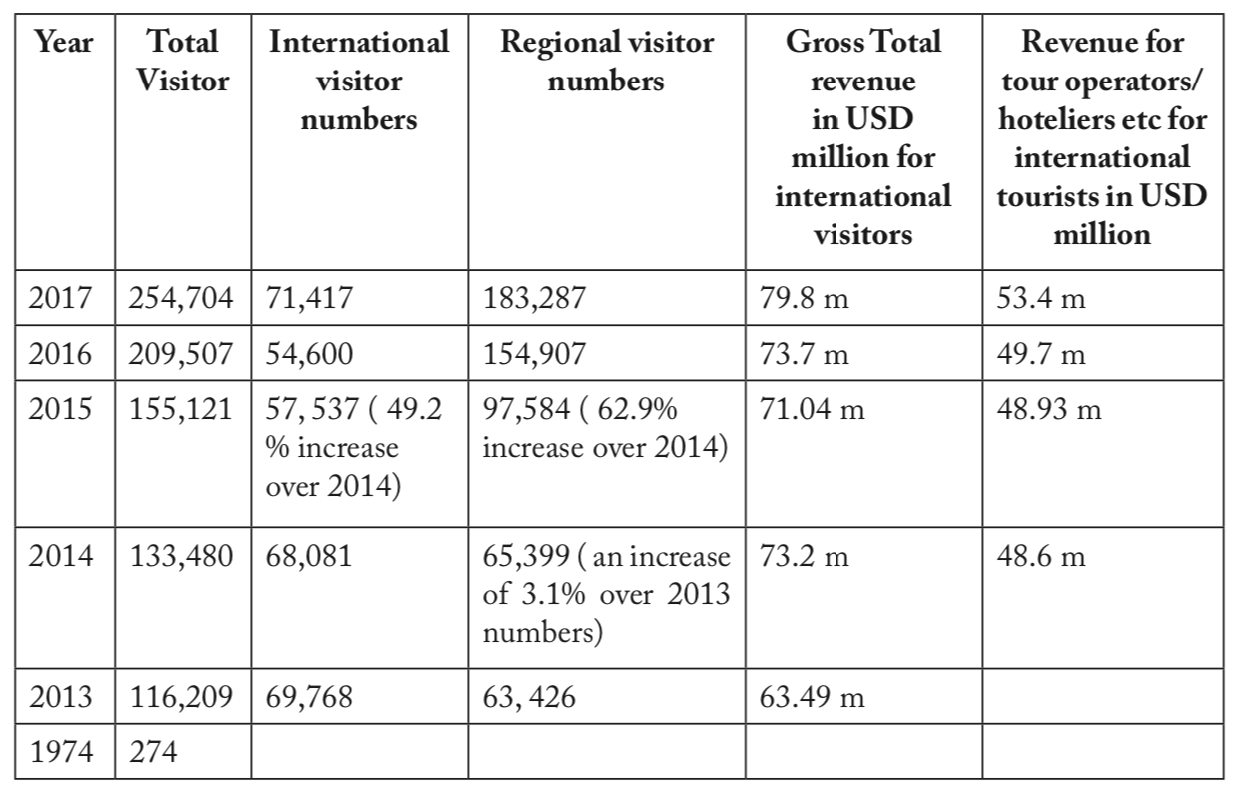
Tourism arrivals in Bhutan (TCB figures), 2008 - 2017. (Graphic: The Druk Journal)
Th ere are 3,100 licensed operators today but industry observers estimate that only about a quarter of them are active. Close to 2,500 guides have been licensed. Tourist class hotels have also grown from seven guest houses before 1991 to 53 international “tourist class” hotels and lodges o ff ering 1,807 beds by 2002. By 2016, there was a total of 267 hotels with 10,278 beds for both foreign and regional tourists. 128 of them are in the 3 to 5 star category and above.
Since 2016, an estimated 132 hotels (3-star and above) have been approved for development in Th imphu and Paro (TCB fi gures). Budget hotels, 2-star and below, are also increasing in numbers. Airbnb, a global online accommodation booking system, advertises about 70 or more Bhutanese properties that enable regional tourists to make direct bookings. Nearly half the regional tourists stay in budget hotels and the earnings from these stays are not available.
Similarly, TCB surveys on regional tourists leaving Bhutan show that on average, about half the regional tourists surveyed individually spend about Nu 5,530/-apart from their normal travel costs 1 . Th is is a fraction of the total spendings of international visitors who represent a third of the total visitors.
Attractions and Access
Nineteen out of the 20 districts in Bhutan are open to tourists but the most popular destinations continue to be the districts of Th imphu, Paro, Punakha, Wangdue Phrodang, and Bumthang, where most of the budget hotels are being built. Th e remote districts have the same features that attract tourists but lack the management, organisation, resources and access.
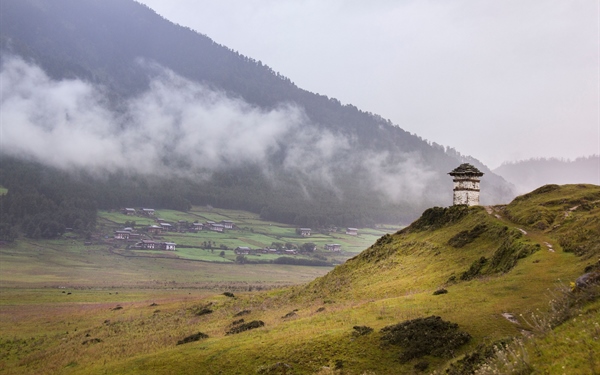
Phobjikha valley in Wangdue Phodrang. (Photo: Druk Asia)
Bhutan has opened 26 trekking routes across the country but two-thirds of them remain di ffi cult to reach and need more facilities and services for high-end treks. Ironically, a part of the problem is the need for special travel permits that require cumbersome procedures. Industry specialists also point to the lack of regulations to govern the construction and occupancy of hotels, and the quality and safety of vehicles that are allowed into the country. Regional tourists without guides have even been spotted camping illegally in the forests. Regional tourists are exempted from the daily tari ff , permitted to drive into Bhutan in Indian vehicles, and stay at non-certi fi ed hotels.
Th is would translate roughly as USD 7.03 million for regional tourist spending above the cost of accommodation which is not available since many go directly to budget hotels. Th e fi gures show that regional tourists bring in just a fraction of the overall earnings compared to international visitors who represent just a third of the tourist numbers.
“We are vulnerable to crowds that will destroy our culture and environment,” says the chairperson of the Association of Bhutanese Tour Operators (ABTO), Rinzin Ongdrak, who acknowledges that Bhutan cannot a ff ord to reduce the tari ff or liberalise the industry to encourage mass tourism. ABTO has called for collaboration amongst stakeholders such as the Guides Association of Bhutan and the Hotel and Restaurants Association, and expects tourism arrivals to reach 500,000 by 2023.
But the numbers that do not pay the tari ff are already threatening to edge out the high-end visitors. Aman Kora’s General Manager, John Reed, quotes agents in the United States as saying that Bhutan is no longer the idyllic and sought-after destination, but one that is prone to mass tourism. High-end operators agree.
Regional and International Tourists
Th e spiralling growth of regional tourists since 2015 has been straining the industry and adding pressure to liberalise tourism. Visitors from India, for example, represent 64.7 percent of tourists who came for leisure in 2016, and 72.7 percent of total arrivals in 2017. In 2017 just one third of tourists paid the tari ff .
“All the regulations in Bhutan regulate the 70,000 international tourists, but there’s almost nothing to guide the regional tourists,” said Yeshey Norbu, proprietor of one of Bhutan’s top three travel agents, adding that this could edge out the international tari ff paying tourists.
David Keen of Quo, a travel industry branding specialist and a regular visitor, says that the early 1990s policy, controlling tourist fl ow, enabled Bhutan to retain its dominant position as one of the most pristine, culturally and environmentally conscious nations on earth.
“With the growth of regional tra ffi c and incrementally a ff ordable tourist fl ow, the environmental, social and cultural impact of huge tourism numbers will continue to erode both perception and the internal infrastructure of the nation,” says Keen.
Environmentalists like Karma Tshering also defend the fi xed minimum pricing system.
“ Th e limited carrying capacity, due to the ecologically and culturally sensitive disposition of attractions and services, means we are already close to reaching our upper limits. Dismantling the pricing system will only mean achieving higher numbers at a faster rate with cheaper costs o ff ering less bene fi ts.”
Increasing Infrastructure in a High Value, Less Occupancy Scenario
Some attempts are being made to control budget travellers. Setting an entry fee to places like the Tiger’s Nest has helped, but the numbers are growing exponentially .
“We can handle more visitors with good management practices,” said Norbu. “But not in the current free-wheeling environment, where no one seems to be taking tough decisions to regulate and manage the industry.”
An often quoted example is that while the Tourism Council regulates the tourist hotels (3-star and above), budget hotels fall under the purview of the Ministry of Economic A ff airs. Airbnb is considered private residences.
Growing tourism is also a ff ecting local residents and municipal services. Parts of Th imphu city are experiencing water shortage. Municipalities worry constantly about waste management, and Th imphu’s land fi ll has long surpassed its lifespan.
“I was shocked to see the garbage everywhere and the tra ffi c jams in Th imphu. It’s not what I expected of Bhutan,” says a fi rst-time visitor from Delhi, who added that the reality in Bhutan was very di ff erent from what he had heard.
Observers point out that even India’s hill stations have had to call for a “de- growth” of tourism as residents are crying out for basic amenities. Th e local population has also been known to turn against the industry and visitors.
Revenue Versus Consequences
Bhutan, too, is receiving calls for de-growth of tourism to protected areas. A 2016 study on Bhutan’s most visited wetland habitats has called for a “de-marketing” of Phobjikha Valley in the absence of regulations and a strict code of conduct. Karma Tshering also an eco-tourism consultant says that Bhutanese authorities and local communities are more reactive than preemptive in averting negative impact. He asserts that Bhutan’s plans to popularise eco-tourism has not yet taken o ff .
A road now runs through Phobjikha’s valley fl oor. Tra ffi c regulations are absent and, without water treatment and septic systems, detergents from even high-end hotels are leaking into the ground. In 2016, Phobjikha had 30 home-stays and 15 hotels. Another seven to eight hotels are in the pipeline. People in Phobjikha report that a helicopter service frightens the Black-necked Crane ( Grus nigricollis ), according to the people.
“Wetland is the heart of Bhutan’s environment, but it’s losing out to the pursuit for economic returns,”says Karma. Th e report states that community involvement needs urgent attention and is critical for the success of eco- tourism. Local community members, however, lament the lack of control and their helplessness as investors from outside build hotels in Phobjikha.
A Disorganised Industry
In 2016, ABTO pointed out that the lack of collaboration and co-ordination in promoting and developing tourism has “stagnated” the industry, with various stakeholders “implementing actions in isolation”. A lack of consultation has led to government approving budget accommodation infrastructure, and banks giving loans for building these budget hotels.
Th e report points out that even the local governments have gradually started to take decisions without consultations hampering the overall operation and development of the industry. Infrastructure development like road expansion is carried out without advance notice and consultations with the stakeholders.
Uncharted growth is more visible by the day. About 100 hotels are currently being constructed in Th imphu and Paro alone-rooms that are multiplying without a business plan and without a vision, and in breach of zoning regulations. In the shortage of quality local products, a deluge of cheap crafts are imported for tourists. An industry analyst predicts that hotel owners, unable to repay bank loans, will soon pressure the elected government to liberalise tourism even further.
“ Th e tail will wag the dog,” he said.
Risks of Uncharted Growth and Possible Solutions
Given Bhutan’s vulnerability, an unregulated tourism sector is not an option. Tourism is a multi-dimensional industry where planning needs to be integrated with the communities involved. ABTO attributes many of the challenges in the tourism sector to the absence of a clear short and long-term progressive vision for the industry to move ahead.
To those paying high fees for exclusivity, “double standards” are not acceptable. Th e TCB believes that the policy needs to be same for all tourists but that it could consider a separate tari ff for regional tourists. Former Tourism Director Chhimmy Pem (this interview was done in 2018 when she was still the director. The director-general of TCB now is Dorji Dhradhul) says that there should be a minimum standard for hotels, tourists should be accompanied by a guide, and there should be rules governing transport.
Th e industry has identi fi ed issues that require clear decisions and action:
Regulations for regional visitors to balance the numbers. Bhutan’s National Council called on the government to endorse a clear policy in Parliament in 2016 that is still awaiting action.
Reports point to the “reverse discrimination” in protected areas. Local communities must be included in planning for sustainable tourism.
Strengthen the capacity of local people to handle visitors and build appropriate services to spread the earnings. Simply providing discounts during the o ff -season is not enough to get people to visit these areas.
Create a more equitable partnership between hotels and tour operators and reduce the dependency on tour operators for hotel bookings.
Spiritual sites are living institutions and should be opened up to visitors with minimal negative impact. Hence, the need for trained guides and crowd control.
Bhutan’s planning document, the Bhutan 2020 report states:
“While giving access to our heritage, we must ensure that those who visit historical and religious sites demonstrate the appropriate respect for these sites. We must also be prepared to place some of our most treasured and hallowed sites beyond the reach of the merely curious, enabling them to retain their mystery and to serve as a source of inspiration”.
Introduce regulations like the green tax on regional cars and motorbikes coming into Bhutan.
Introduce updated regulations on monitoring and approval of the building of hotels. Encourage budget hotels to upgrade to a minimum of 3-star status to maintain the “high value” principle.
Formally introduce the TCB e-permit system to reduce the long queues in the Phuentsoling checkpost and to enable the industry to track the number of regional visitors coming into Bhutan.
At the rate at which budget hotels are expanding, Bhutan has to make a decision urgently.
As the world grapples with over-consumption and growth, the new catchphrases emphasise the opposite-de-growth, de-marketing, slow tourism to resist the growth fetish. Th is thinking was pioneered in Bhutan when it began tourism, and has been the subject of study and recognition by other countries. TCB believes that the Sustainable Development Fee must remain.
“Countries like Japan and New Zealand are trying to copy Bhutan and introduce tourism fees; it’s better we keep what we have,” says Madam Chhimmy.
Destinations inspired by de-growth thinking are wary of the homogenising impacts of globalisation. Th ey do not have international retailers nor fast -- food outlets, but instead promote local distinctiveness and a sense of place and local identity. By doing so, they attempt to reduce the scale of the socio-economic system so that it will fi t within the natural limits of their locality and capacity, such as the case of Phobjikha as a destination.
Veteran tourism stakeholders remind us of the many countries that came to study the high end, low impact model and how Bhutan is now, ironically, on the brink of tipping over if the complacency continues. If there’s one challenge of Bhutan’s democratic change, it is the ability -- or inability -- of newly elected governments to deal with a multi-dimensional industry and to take tough and clear decisions for the long-term.
While TCB defers to the government to make the tough decisions on regional tourism, the governments elected by the people do not seem to have the con fi dence to take these decisions, and have not prioritised tourism as an issue.
A draft Tourism Bill was prepared nearly 10 years ago but was never put to Parliament for adoption. Some measures were introduced, including the setting up of a Tourism Council to regulate the industry. Last year, the National Council raised the issue of passing the Bill but the government delayed decision on it.
In 2016 His Majesty Th e King reminded Bhutan’s youth :
“... tourism as an industry was only introduced after the Coronation of His Majesty the Fourth Druk Gyalpo. It was suggested to us then that Bhutan would benefit economically from bringing in as many tourists as possible into the country. At that time, Bhutan was largely unknown to the outside world. And yet with Drukgyal Zhipa at the helm, we had the confidence to make our own decisions, to decide that our approach to tourism policy would be that of high value low volume. It seemed counter- intuitive at a time when tourists coming to Bhutan were so few. There were many sceptics. But because of that policy, Brand Bhutan emerged. And you see the results of that policy for yourselves today. People who make it to Bhutan feel privileged to be our guests. In hindsight, we realise the profound wisdom of that decision, but we could have easily gone the other way had it not been for that conviction we had to forge our own path, our future, and our destiny.”
Has Bhutan forgotten this wisdom?
This article was first published in The Druk Journal , Vol. 4, Issue 4, and has been edited for Daily Bhutan.
Bhutan Holds First National Tourism Conference: Here Are Some Key Takeaways
Upcoming events.
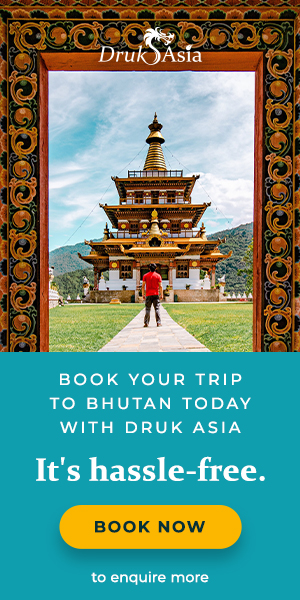
Related Posts
Bhutan holds first national tourism conference: here are some key....
Organised by the Tourism Council of Bhutan (TCB), the conference on Wednesday and Thursday saw around 200 participants...
Rifles and Rituals: Satire and Societal Shifts in Bhutan as...
Pawo Choyning Dorji, whose film "The Monk and the Gun" offers insight into the Himalayan nation's modernization process.
All You Need to Know About Gelephu Mindfulness City
The kingdom of Bhutan is planning to develop a "mindfulness city" covering about 2.5% of its land, which is larger than...
Bhutanese artist wins one of Asia's top art contests
The International Artist Grand Prize Competition is held in Taipei, Taiwan.
Art United: A Contemporary Vision' Exhibition Now Open to Public
'Art United: A Contemporary Vision' Exhibition was unveiled by Her Royal Highness Ashi Sonam Dechan Wangchuck
Bhutanese Students Get Ready to Compete In First Global Robotic...
Five students from Bhutan will compete in the First Global Robotic Competition in Singapore, which is themed Hydrogen...
His Majesty King Jigme Khesar Visited Singapore And Shared About Gelephu Mindfulness City
On the 5th April 2024, Opera Gallery, an international gallery specializing in modern and contemporary art celebrated its 25th anniversary...
Prime Minister Narendra Modi's Historic Visit to Bhutan: Strengthening Bonds and Building Partnerships
India's Prime Minister, Shri Narendra Modi, arrived at Paro Airport for a two-day State Visit to Bhutan from March 22nd to 23rd, 2024.
Rifles and Rituals: Satire and Societal Shifts in Bhutan as Portrayed in 'The Monk and The Gun
The kingdom of Bhutan is planning to develop a "mindfulness city" covering about 2.5% of its land, which is larger than the size of...
Brand Bhutan: Karma Yangchen
Karma Yangchen, a distinguished artisan from Bhutan exemplifies a profound commitment to the art of handwoven textiles.
Brand Bhutan: Bhutan Herbal Tea
Bhutan Herbal Tea is the brainchild of two Bhutanese individuals who first crossed paths in New York during a Bhutanese New Year gathering...
Subscribe to our newsletter
Never miss out on new happenings and news stories!
Bhutan Cricket's New Milestone: The Inaugural Indoor Cricket Academy
The Bhutan Cricket Council Board (BCCB) inaugurated its inaugural indoor cricket academy on 20th December, with the objective of ensuring...
Paro FC Clinches Third Consecutive Victory in BOB Bhutan Premier League
Paro FC has once again claimed the BOB Bhutan Premier League championship, marking their third consecutive title victory during the season's...
Alii Palau Airlines Inaugural Flight From Singapore to Palau via Drukair
On November 23, 2023, Alii Palau Airlines made history with its inaugural flight to Palau.
Singapore to Palau: Alii Palau Airlines Launches Historic Route With Drukair
You can now visit the Palau Paradise directly from Singapore!
Chunipa Losar: Bhutan's Timeless Celebration of Traditions and Offerings
Chunipa Losar is a day of offerings, a moment when communities come together to express gratitude, seek blessings, and strengthen bonds.
Bhutan's Time-Honored Tradition: Exploring the Nyilo Season and the Lolay Ritual
Approximately 750 children recently took part in the traditional practice known as "lolay" in Bhutan, marking the beginning of the Nyilo...
Download Daily Bhutan Mobile App
Connecting with us just got easier!

More From Forbes
Fans of ‘the tourist’ will love the new netflix series ‘bodkin’.
- Share to Facebook
- Share to Twitter
- Share to Linkedin
Will Forte, Siobhán Cullen, and Robyn Cara in 'Bodkin' coming to Netflix soon.
It’s all about the luck of the Irish over at Netflix with two fun mystery series. Viewers who loved The Tourist will want to binge-watch the new darkly comedic thriller, Bodkin , premiering on May 9.
The seven-episode series tells the tale of a crew of true crime podcasters (Will Forte, Siobhán Cullen, and Robyn Cara) who set out to investigate the disappearance of three strangers in the fictitious quaint, coastal Irish town of Bodkin. (It’s so charming, but before you try to book your tickets to go there, this imaginary place is situated in West Cork and was filmed in both Union Hall and Glandore, as well as parts of Wicklow and Dublin).
This small, tight-knit community is hiding some pretty big secrets and many of the locals aren’t happy with the intrusion. The town’s charming topography covers up some nefarious goings-on and the last thing the people there want is for the world to know anything about any of it.
As in the Jamie Dornan-helmed Tourist, this series centers around unraveling a longtime mystery with a wacky cast of characters forced to endure a hilarious set of circumstances. Both are fish-out-of-water stories that draw you in with gripping mysteries. Bodkin , like The Tourist , will also keep you laughing at the lengths these people will go to get to the truth.
This trio has traveled to this village to do a podcast about the Samhain Festival, the American equivalent of Halloween. On that night 20 years ago, three people went missing during the festival.
Best High-Yield Savings Accounts Of 2024
Best 5% interest savings accounts of 2024.
At first, they’re not even sure there’s a story to tell, but these podcasters are determined to discern fact from fiction and soon realize that what happened in this small town decades earlier is much bigger and weirder than they could have imagined.
Forte plays Gilbert, an enthusiastic American podcaster with Irish roots on the hunt for his next big story. Years ago, he made a wildly successful podcast, but every podcast he’s made since has been a huge flop. His outwardly sunny disposition hides his financial and marital problems.
He uses his charm to gain the people’s trust but the viewer becomes privy to the fact that he has a lot on the line. He has to uncover a juicy story or he could lose everything.
Contrary to his outwardly positive attitude, Cullen plays a hard-nosed investigative journalist named Dove. She lives in London but is originally from Dublin. She has a healthy disdain for authority and hypocrisy and a keen sense when it comes to detective work. People find her to be rude and rough around the edges. It isn't helping matters that she’s simultaneously going through the biggest professional crisis of her career.
Cara portrays a funny, hardworking, and eager-to-please researcher, Emmy, who has helped Gilbert organize the podcast. There’s a natural chemistry between the three and their shared scenes are fun to watch.
'Bodkin' is coming to Netflix on May 9.
Once they arrive, they meet Seamus Gallagher (David Wilmot), a mercurial and mysterious local who can turn on the charm when it serves his needs; on the flip side, he can just as quickly snap into outbursts of violence when he feels threatened.
They also meet Seán O’Shea (Chris Walley), an unreliable country lad who they come to learn is wrapped up in some pretty shady business, and completely out of his depth.
Bodkin is created and executive produced by Jez Scharf, who also serves as co-showrunner alongside fellow executive producer Alex Metcalf. The series hails from Barack and Michelle Obama’s Higher Ground production company, and the former White House residents serve as executive producers alongside Tonia Davis, their head of film and television, and Nne Ebong, David Flynn, and Paul Lee. Nash Edgerton is the lead director.
Scharf described his love of real-life crime stories to Netflix’s Tudum. “Whenever I listen to a true crime podcast, I always think about what it must be like to be that researcher on the ground, in that town, knocking on doors, trying to get people to open up about their most traumatic and difficult experiences, and how absurd that might feel.”
He added, in part, his interest in using the creation of a true crime podcast as a vehicle for a detective story. He also wanted to delve into the divide between truth and story. “It's something I have questioned a lot.”
There’s something extremely entertaining about watching these characters unravel what happened decades earlier while simultaneously figuring out the truth about their lives amidst the backdrop of this mysteriously dark Irish town.
The truth, as Gilbert, Dove, and Emmy learn, isn’t always black or white. There are always varying shades of gray.
Here is some fun behind-the-scenes .

- Editorial Standards
- Reprints & Permissions
We've detected unusual activity from your computer network
To continue, please click the box below to let us know you're not a robot.
Why did this happen?
Please make sure your browser supports JavaScript and cookies and that you are not blocking them from loading. For more information you can review our Terms of Service and Cookie Policy .
For inquiries related to this message please contact our support team and provide the reference ID below.

IMAGES
VIDEO
COMMENTS
Abstract. Luxury tourism is an emerging area of research and deserves consideration for its implications for tourism and hospitality management and policy development. This chapter reviews the phenomena of luxury tourism in the academic literature and in particular, its links to the concepts of high yield, sustainability and tourist experiences.
Wellness tourism equates to high-yield tourism. Luxury wellness travelers are now willing to pay a premium for healthier hotel stays and wellness products and services while traveling. Wellness tourism is booming in emerging markets. Asia-Pacific, Latin America, the Middle East, and Africa are emerging as wellness destinations of choice ...
The nine-minute film has earned more than 50 million views as part of the organization's ongoing effort to boost tourism numbers from high-yield US travelers - the second-largest international ...
The "high yield tourist" is something governments and private business know is very important - it brings in travelers who spend more money than other tourists often do. Also wellness tourists often don't do as much damage to a country's environment and thus are attractive from that point of view also. The concept reminds me of the ...
A search on the term "high-value travelers" notes they are likely to spend more, stay longer, and disperse beyond hotspots. Additionally, they're motivated by nature, wildlife, aquatic, food, and hands-on experiences. So, there you go: The high-value traveler as defined by the tourism industry. Yet, these definitions still tend to feel a ...
Our target audience. Tourism Australia now identifies its target audience as High Yield Travellers (HYT). This move from a global psychographic segment to more specific audience segments by market aligns well with the high yield strategy. This shift from HVT to the HYT has increased Tourism Australia's total addressable audience size.
Earlier this year, the island country's tourism minister reiterated a plan to attract wealthy tourists over those who campervan around the country "on $10 [€7] a day by eating dried noodles."
Wellness tourism is high-yield tourism. Wellness travelers spend more per trip than the average tourist, and this holds true for both domestic and international travelers. In 2017, international wellness tourists on average spent $1,528 per trip, 53% more than the typical international tourist. The premium for domestic wellness
High yield luxury tourism, 405-407. conceptualisation and key distinctions, 413-414. demand perspectives on luxury tourism, 409-412. destination image, 414. luxury in tourism, 408-409. managerial implications, 414-415. supply perspectives on luxury tourism, 412-413. sustainable yield tourism
RealNZ focuses to low-volume, high-yield tourism. RealNZ has launched two new experiences for smaller groups but at an increased yield. The new Milford Sound Premium experience offers a smaller vessel, lower guest numbers, and high-end food and beverage offerings including canapes and bubbles while on board. The Walter Peak Eco experience ...
Since the notion of a 'high yield' tourist will differ according to the different concepts of yield, clarification of the 'yield' concept becomes an important topic in analysis of the 'ideal tourist'. The first aim of the paper is to classify different economic attributes of the 'ideal tourist'. It will be argued that several ...
Since the notion of a 'high yield' tourist will differ according to the different concepts of . yield, clarification of th e 'yield' concept becomes an important topic in analysis of the ...
Global Wellness Tourism Economy - November 2018 | 5 Wellness tourism is high-yield tourism. Wellness travelers spend more per trip than the average tourist, and this holds true for both domestic and international travelers. In 2017, international wellness tourists on average spent $1,528 per trip, 53% more than the typical international tourist.
Ecotourism is a high yield tourist category within the national tourism industry and issues such as site planning and development, operator obligations and best practice, strategic management and the role of indigenous communities have become crucial professional and industry considerations.
CONCLUSIONS. Bhutan has been able to minimize the environmental and cultural impacts of western tourists through its low-volume, high-yield tourism policy. However, this policy is limited only to western tourists, while the impacts of a growing number of regional tourists on the environment and culture is ignored.
In financial terms, developing 'high yield' tourism is often articulated as moving away from priceconscious mass tourism towards encouraging categories of tourism where income contributed to the ...
Its director, Danny Rueda-Cordova, says this may be increased to refocus on low-number/high-yield tourism. He says visitor numbers fell from a record 270,000 in 2019 to half that in 2021 at the ...
Top Bank Account for International Travel Benefits. Ally Savings Account. Bask Bank Mileage Savings Account. Capital One 360 Checking. Schwab Bank High Yield Investor Checking® Account. SoFi ...
The relevance of TBL reporting to the notion of yield in tourism has not been addressed to date. It is an objective of this report to help to develop standardised, consistent, measurement and reporting methods of tourism yield which are consistent with the TBL approach. measuring tourism's economic yield: recent results of tourism
Building on the strengths of the first edition, the text discusses the significance of ecotourism in the domestic and international tourism sector. Ecotourism is a high yield tourist category within the national tourism industry and issues such as site planning and development, operator obligations and best practice, strategic management and ...
• Tourism sectors generally have positive financial yields. However, many sectors of tourism have yields which are low compared to the opportunity cost of capital, and to some of the better performing sectors elsewhere in the economy. There is a high variance in financial yield within each sector, suggesting there are no inherent
The Beginning . Bhutan opened its doors to tourism in 1974 with an image of exclusivity enhanced by its cautious high-yield tourism policy. Th e government charged USD 200/-to 250/-a day for foreign visitors, to control low spending, high impact tourists, or low spending tourists who tend to typically leave a higher carbon footprint with greater impact on the environment.
It's all about the luck of the Irish over at Netflix with two fun mystery series. Viewers who loved The Tourist will want to binge-watch the new darkly comedic thriller, Bodkin, premiering on ...
high-yield traveler: a traveler who makes large purchases.Option (C) is hence the appropriate response. What is meant by Tourism? Whether it's for business or pleasure, tourism is the industry that organizes and advertises travel. In a broader sense, according to the World Tourism Organization, tourism is the act of "going to and staying in areas beyond their typical surroundings for leisure ...
Florida's high-speed rail system, Brightline, is tapping the US high-yield market with a $1.25 billion offering on Monday. The Fortress Investment Group-backed railroad is selling six-year ...